Review of the Corsair MP600 PRO LPX PCIe Gen 4 NVMe SSD
When Corsair released their first high performing SSD entry onto the PCIe 4 m.2 NVMe tier, they did so into a significantly less crowded marketplace than it is right now. The MP600 was one of the first Phison E16 SSDs to arrive on the scene and it made quite the mark! Then the Phison E18 prosumer model arrived in the MP600 Pro (Originally reviewed here on NASCompares, it scored very well in its review and benchmark ), but fast forward to 2022 and corsair have revisited this SSD with a new heatsink and tweaked firmware (optimized in favour of PS5 utilization) in the new Corsair MP600 Pro LPX. This new revision of the Corsair MP600 embraces some physical differences in the heatsink (changing the rather beefy PC targetted H/S), but for the most part is the same SSD, with the same architecture as the MP600 that came before it. That said, with the boost in SSD deployment in PS5 consoles around the world, the move by the brand to make their flagship prosumer SSD more accessible to that market makes a lot of sense. That said, is this the same old SSD with a simple paint job? What sets the Corsair MP600 Pro LPX apart from its predecessor? Let’s find out.
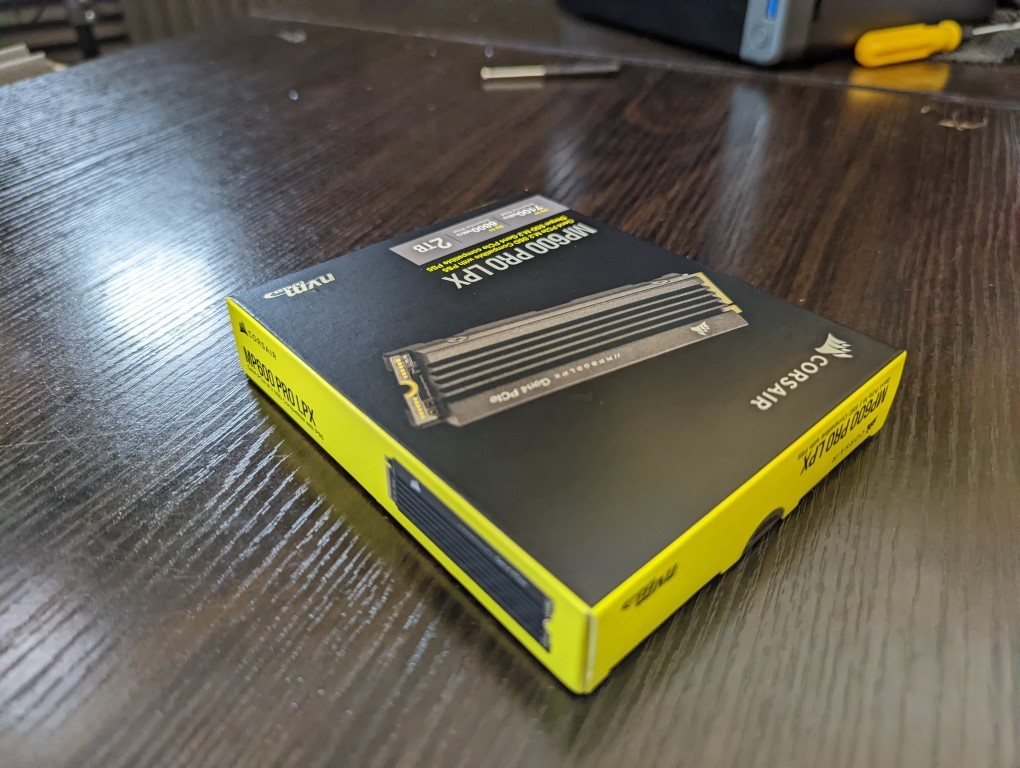
Corsair MP600 PRO LPX SSD Review – Quick Conclusion
Arriving as a slight change on the blueprints of the previously released Corsair MP600 Pro, the newly PS5 optimized Corsair MP600 Pro LPX is very much a second helping of what that same SSD did previously. It does bring a few tweaks into the mix (modified Heatsink, improved NAND, etc) but if you are already an owner of the PC focused MP600 Pro, there isn’t going to be much new for you here. However, if this is your first time considering the Corsair MP600 Pro LPX as your gamer SSD of course, is it a remarkably solid, well built and understated piece of storage! Performing remarkably well in testing on the PC and PS5, this IS a good SSD. That said, the PCIe Gen 4 SSD market is fast becoming a very crowded place and despite its pluses, the Corsair MP600 Pro LPX may be in danger of fading into the background. Luckily its pricing appears more dynamic than many out there (even at its launch) and the Corsair name carries enough kudos in the PC market to get picked up by console gamers nonetheless. A good SSD that, had it been released just 6 months before, I think would have made a bigger noise for buyers to hear! PS5 Buyers, don’t hesitate! PC buyers, maybe save a few quid and opt for the MP600 Pro standard version.
Corsair MP600 PRO LPX SSD Review – Packaging
A close look at the retail box of the Corsair MP600 Pro LPX shows us that this range differs ever so slightly from the original version and its yellow/black design. The box is fairly monotone and conservative, lacking the loud luminous yellow of its predecessor.
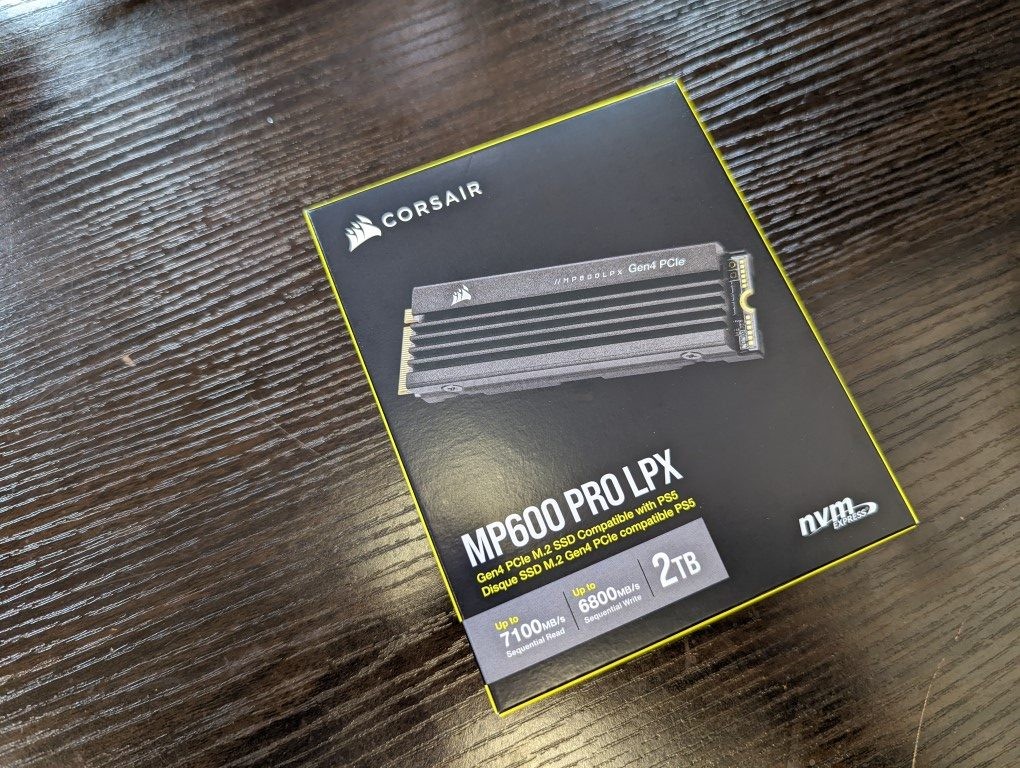
The retail box shows us the familiar rigid packaging we saw in the Corsair MP600 Pro, as well as the inclusion of installation instructions and warranty information. All fairly standard stuff.
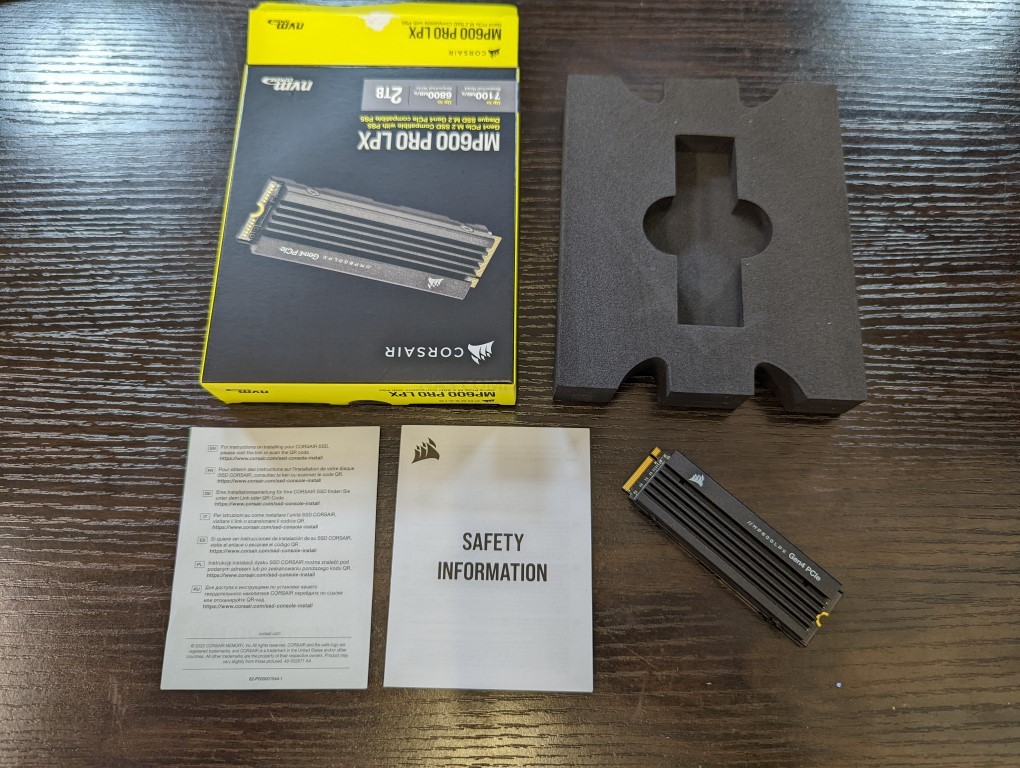
There are details on the box regarding the performance of the Corsair MP600 Pro LPX, as well as further information on how well this SSD performs. Much like the Corsair MP600 Pro original version, the new LPX release is remarkably restrained in its reported performance from the brand (in our testing of its general predecessor, we would it could achieve a good 10-15% more than the brand implied. Let’s hope this is the case once again.
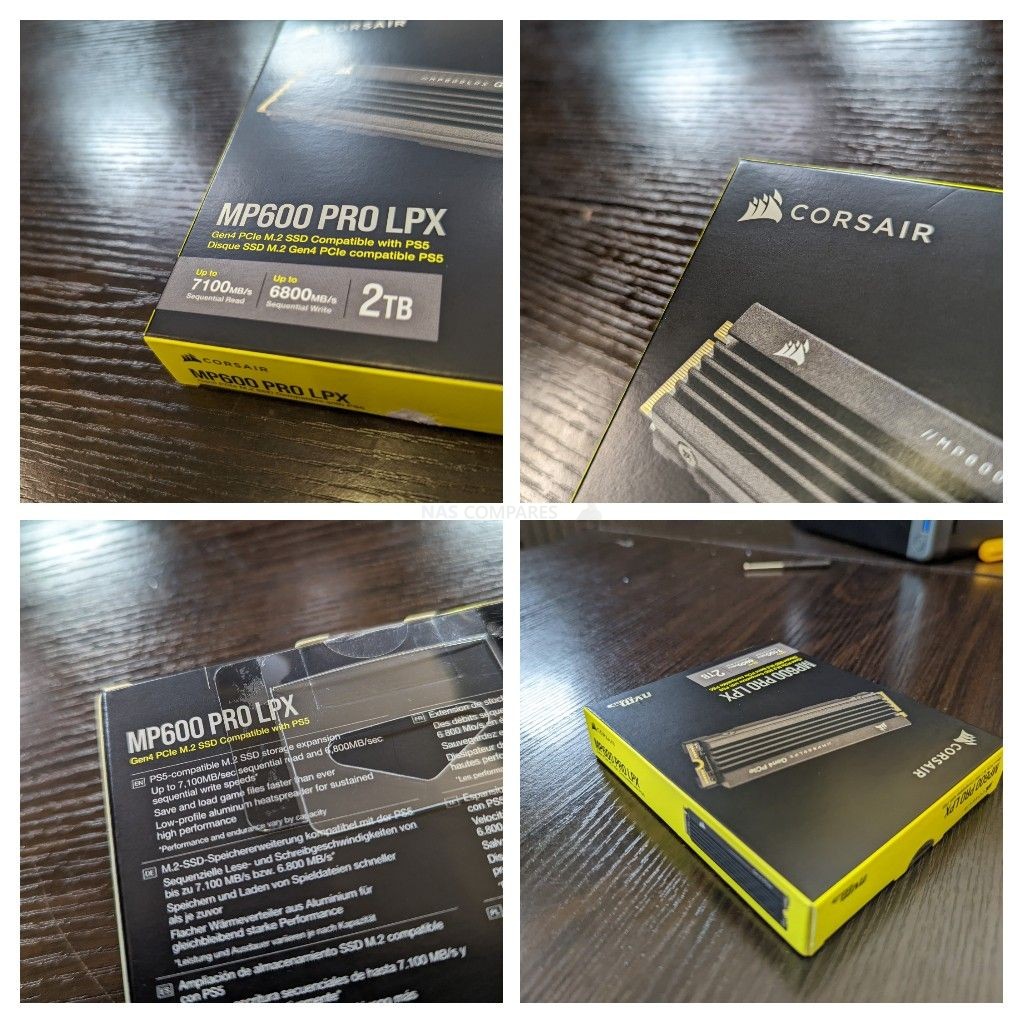
Removing the SSD from all the retail packaging, we find the SSD and its PS5 optimised heatsink. Quite similar to the Nextorage NEM-PA discussed here on the channel a couple of weeks ago, the Corsair MP600 Pro LPX SSD is a chunky but low profile m.2 heatsink that features multiple airflow channels for assisting heat dissipation. However, this SSD heatsink will likely be encased in the PS5 SSD expansion slot and that will marginally limit airflow.
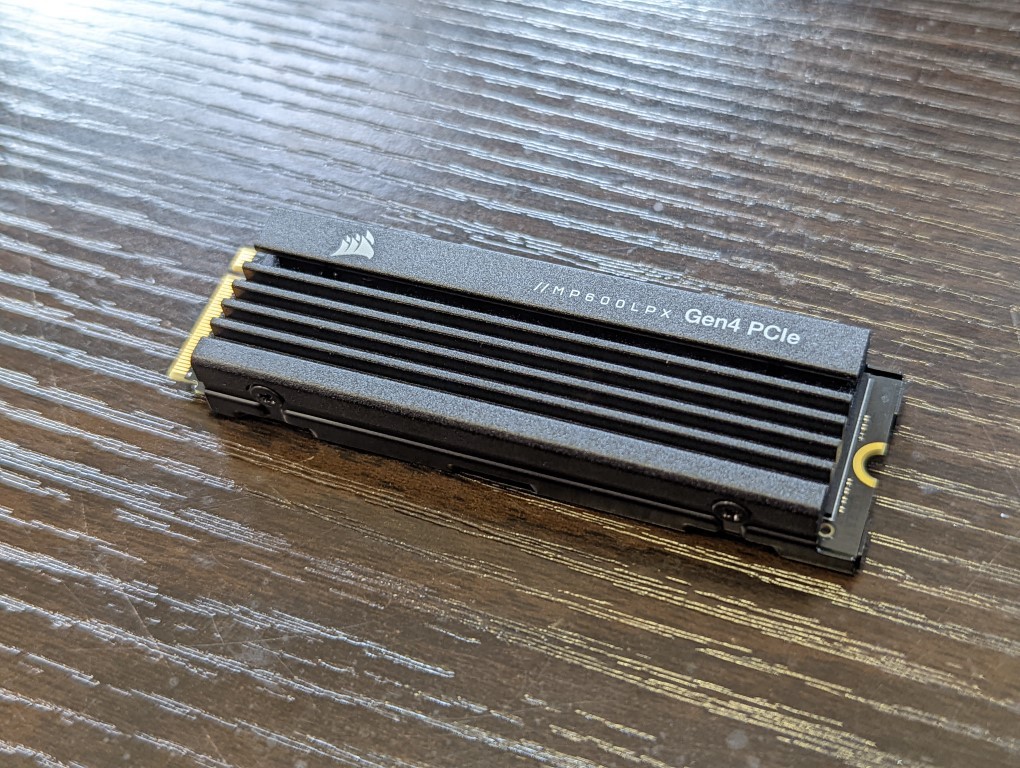
The Corsair MP600 Pro LPX SSD heatsink though is still quite coversome and surrounds the SSD very neatly. Arriving as a pre-installed heatsink purchase, this SSD arrives tightly cases inside the aluminium surrounding case.
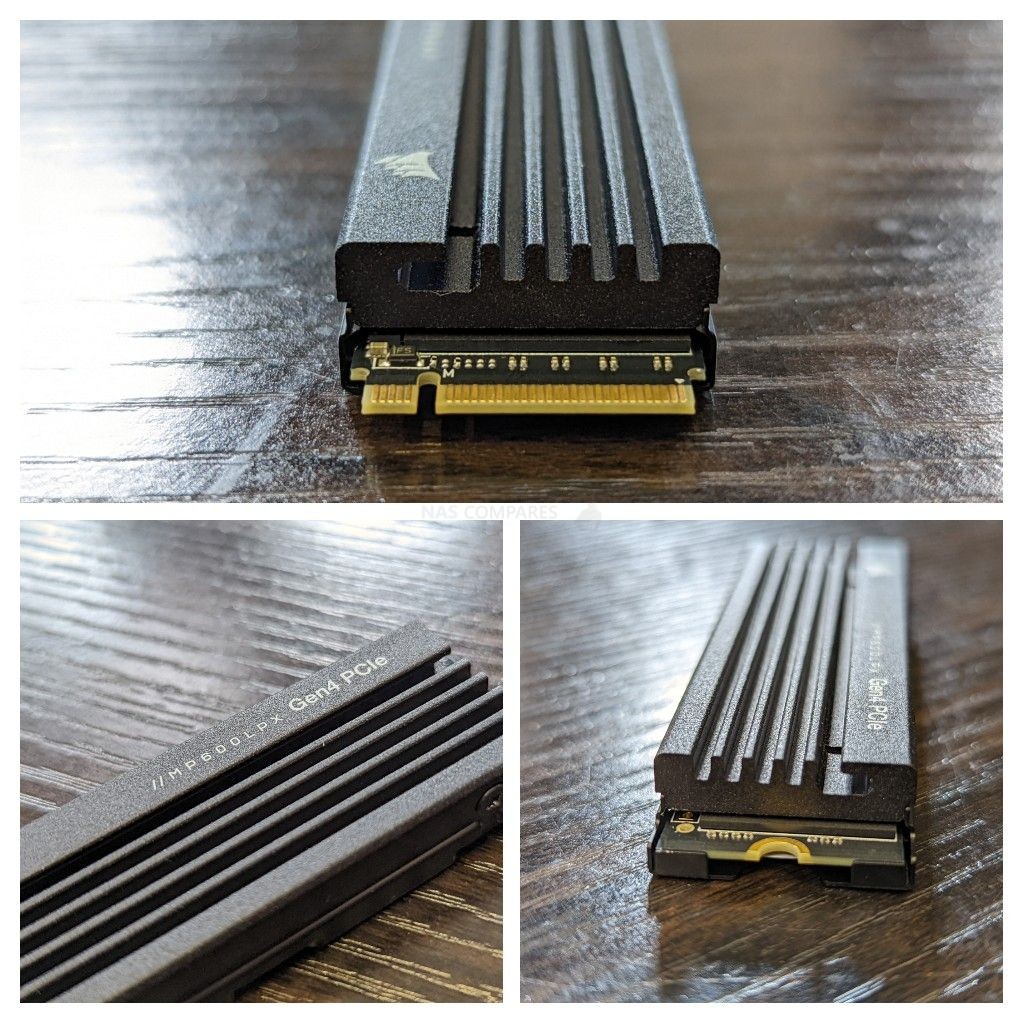
With so many first party SSD heatsinks arriving in the market (largely due to the increased heat generated by PCIe 4 Performance generally), the Corsair MP600 Pro LPX heatsink still manages to be a little generic but is certainly built to a standard that I feel it will do the job it is built for. The heatsink has been clearly designed to fit inside the PS5 m2 SSD expansion slot (hence the several references to the console on the retail packaging) and I am pleased to confirm that it fits without a hitch! I’m still not a huge fan of the covered design of the SSD slot on the PS5, but still, this heatsink has adapted well compared with the standard MP600 model.
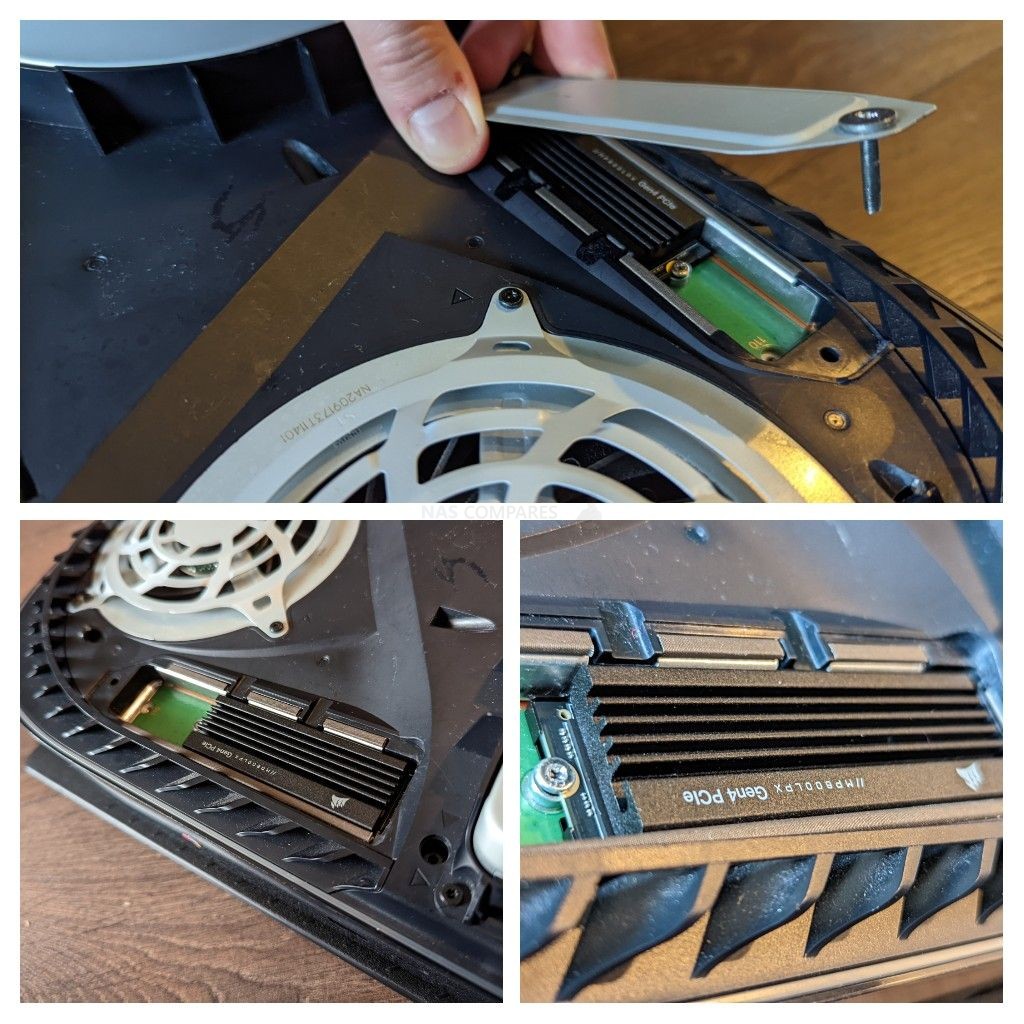
The heatsink on the Corsair MP600 Pro LPX in a PS5 deployment seems a good fit, but when we performed our PC benchmarks (detailed later in the review) it should be noted that the temperature of the controller rose a pinch higher (around 10-12 degrees) higher than most other similarly designed SSD+Heatsink combos, peaking at the most intense testing at 57 degrees. This is still well within the operational temperatures of this SSD to perform, but I have seen similar architecture SSDs (in the controller, NAND, memory) to the Corsair MP600 Pro LPX maintain the temperature better and that is often down to the heatsink being chunkier or a larger surface area in a PC environment to capture active airflow.
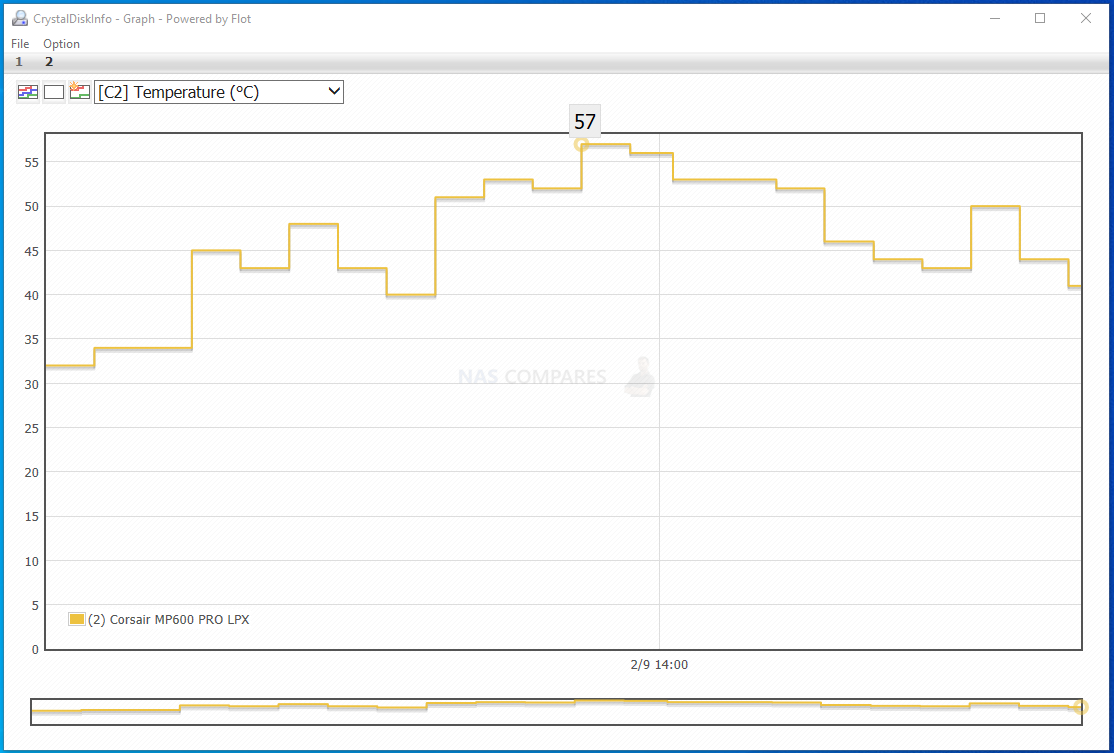
When installing the Corsair MP600 PRO LPX in the PS5, we performed a benchmark using the system’s own tool several times and although the highest it achieved was 6388MB/s, the best average temp was around 6300-6400MB/s.
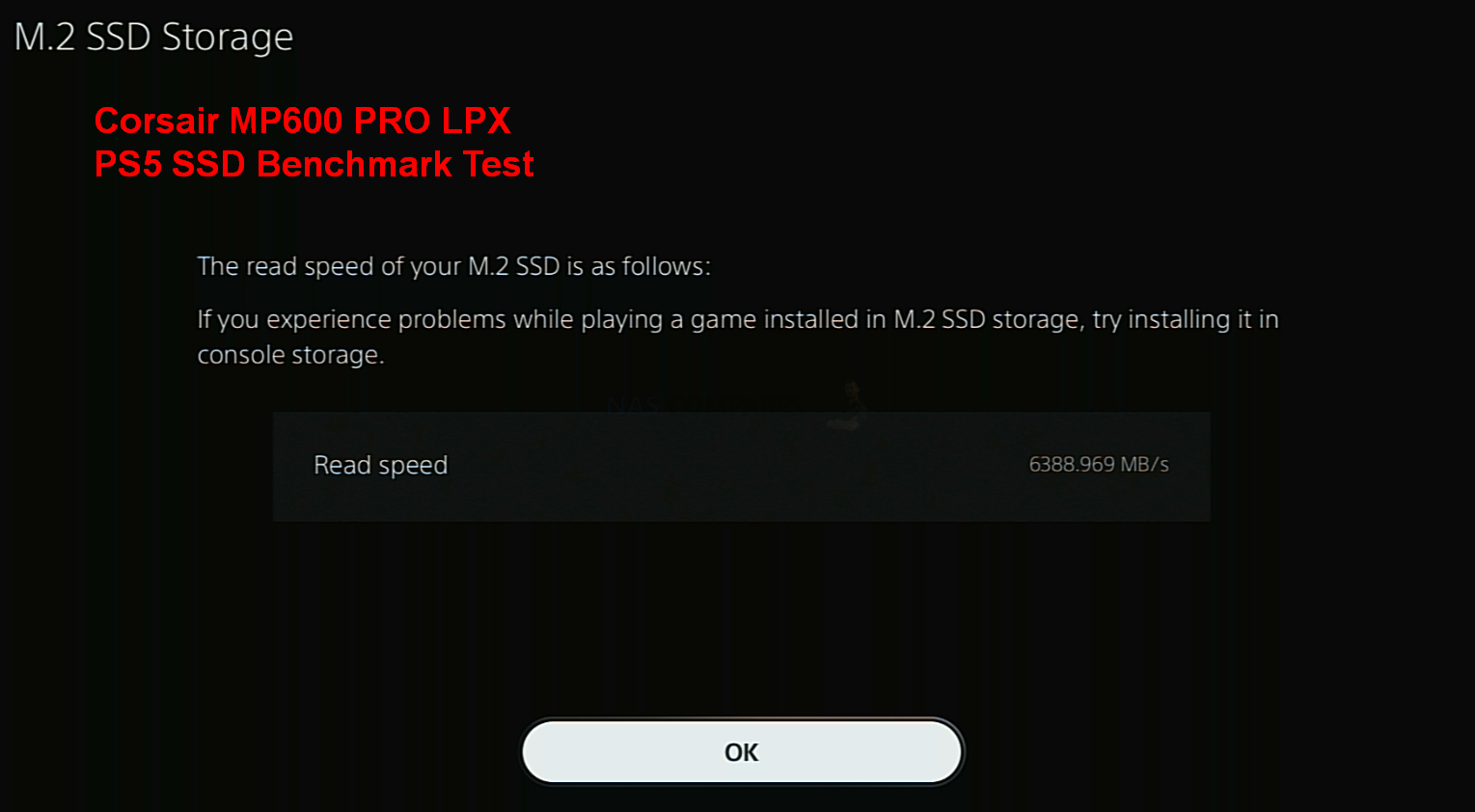
As you would expect, the SSD immediately appeared in the PS5 storage manager and was available for use straight away.
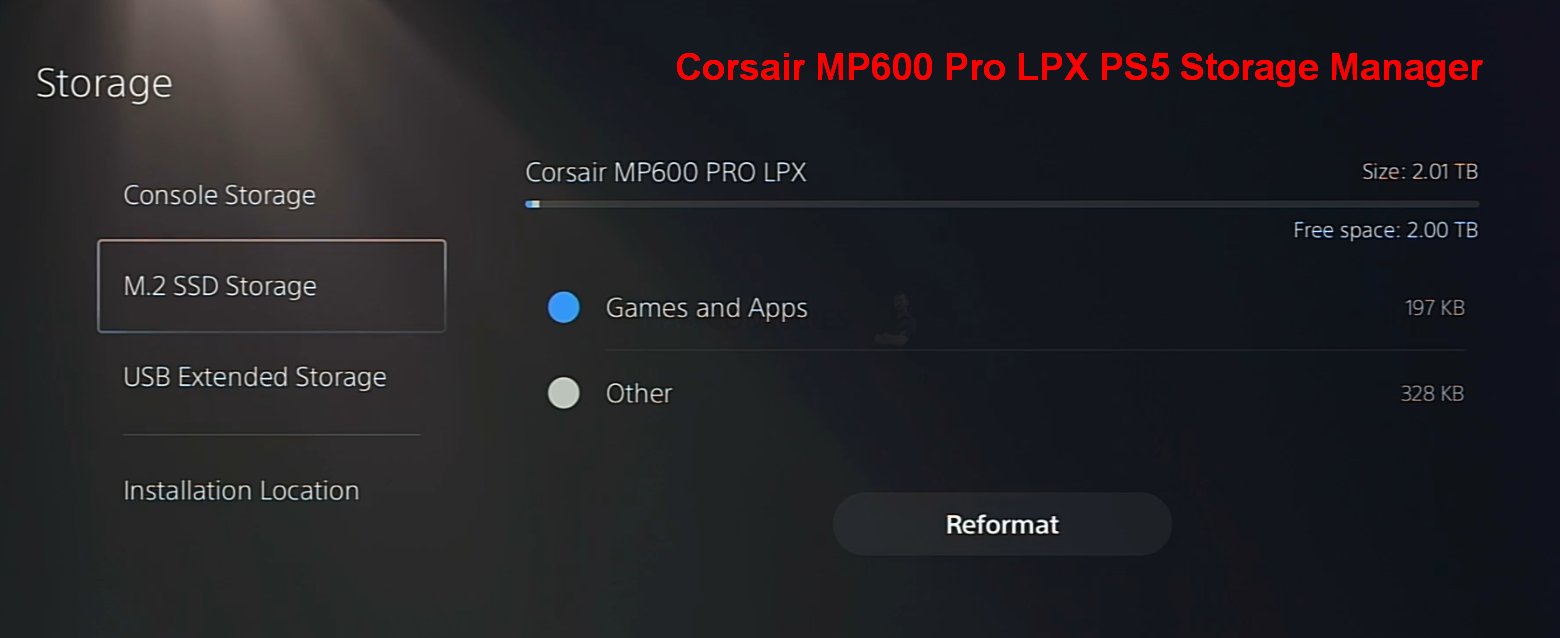
Full PS5 Games Loading testing of the Corsair MP600 Pro LPX NVMe SSD will be coming soon to the YouTube channel here on NASCompares, but in the meantime, here is how it compared again games loading on 6 games against the internal PS5 SSD:
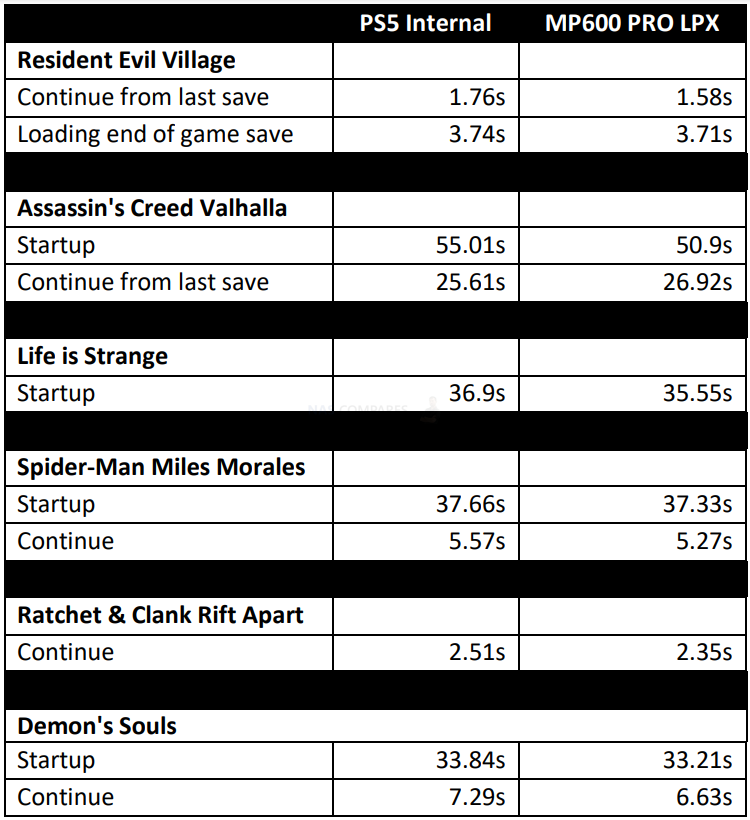
Let’s see how the Corsair MP600 PRO LPX PS5 benchmark compared with other SSDs we have tested.
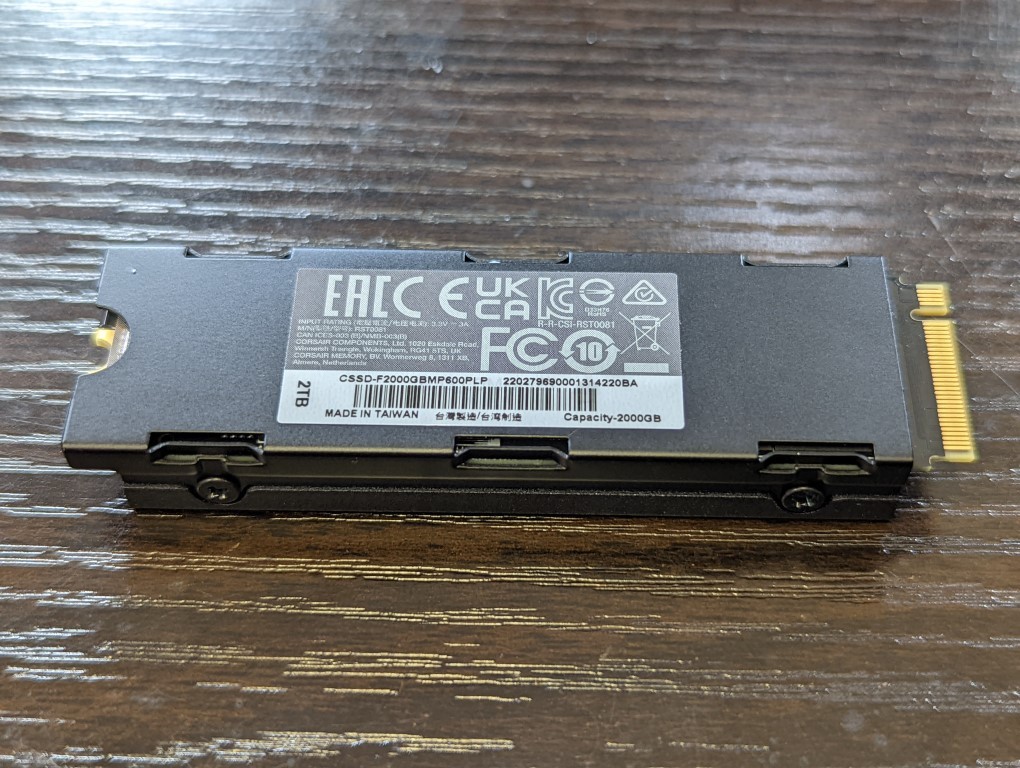
Corsair MP600 PRO LPX SSD Review – PS5 Benchmark
To put the Corsair MP600 PRO LPX SSD PS5 Performance Benchmark into a little perspective, here is how it compares against the Addlink A95, Adata XPG Gammix S70, Sabrent Rocket 4 Plus and Gigabyte Aorus 7000s – four SSDs that are all PS5 supported and VERY similar architecture very little difference between the others in this tier, it is a solid benchmark.
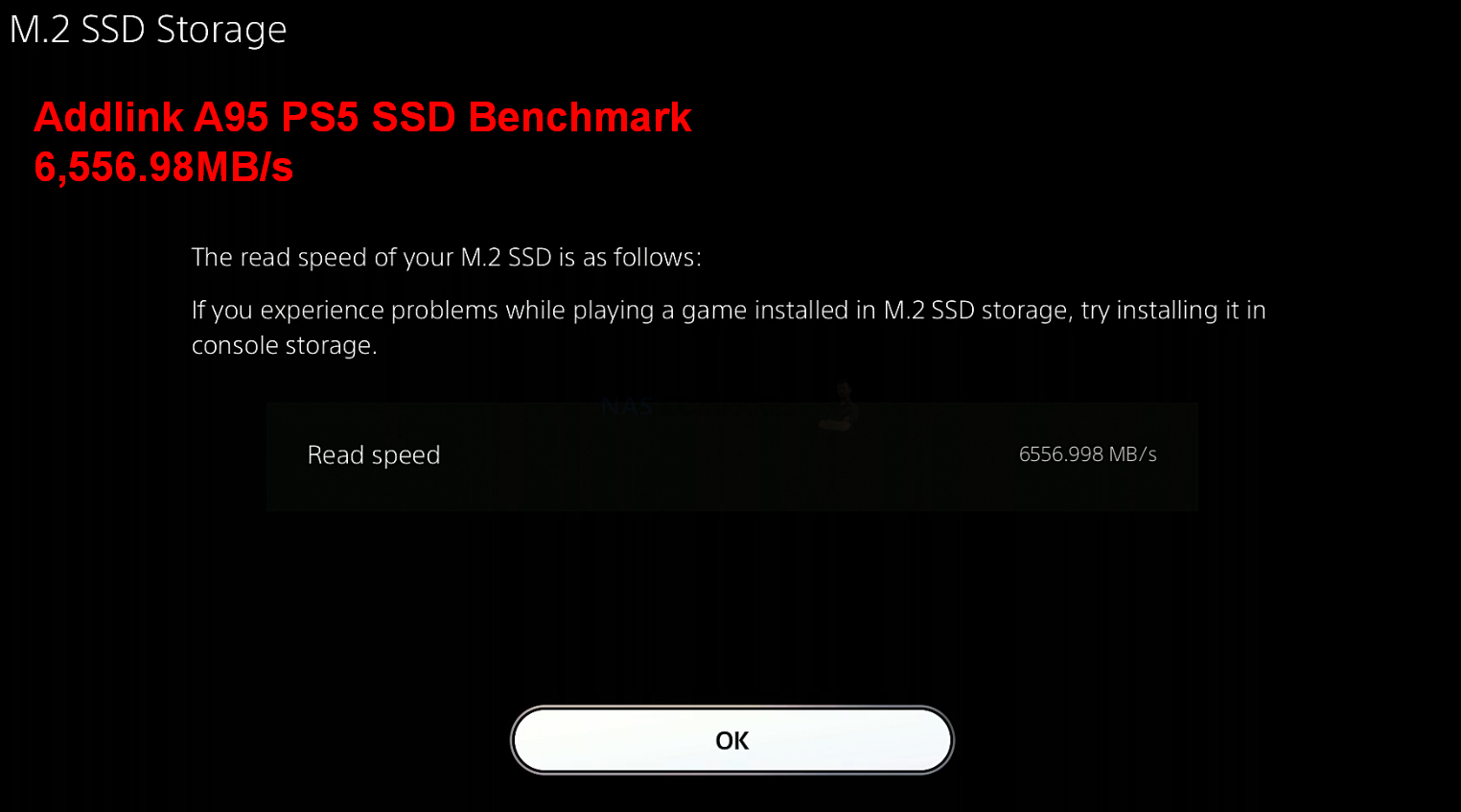 |
 |
| Addlink A95 PS5 Benchmark – 6556MB/s | XPG GAMMIX S70 PS5 Benchmark – 6235MB/s |
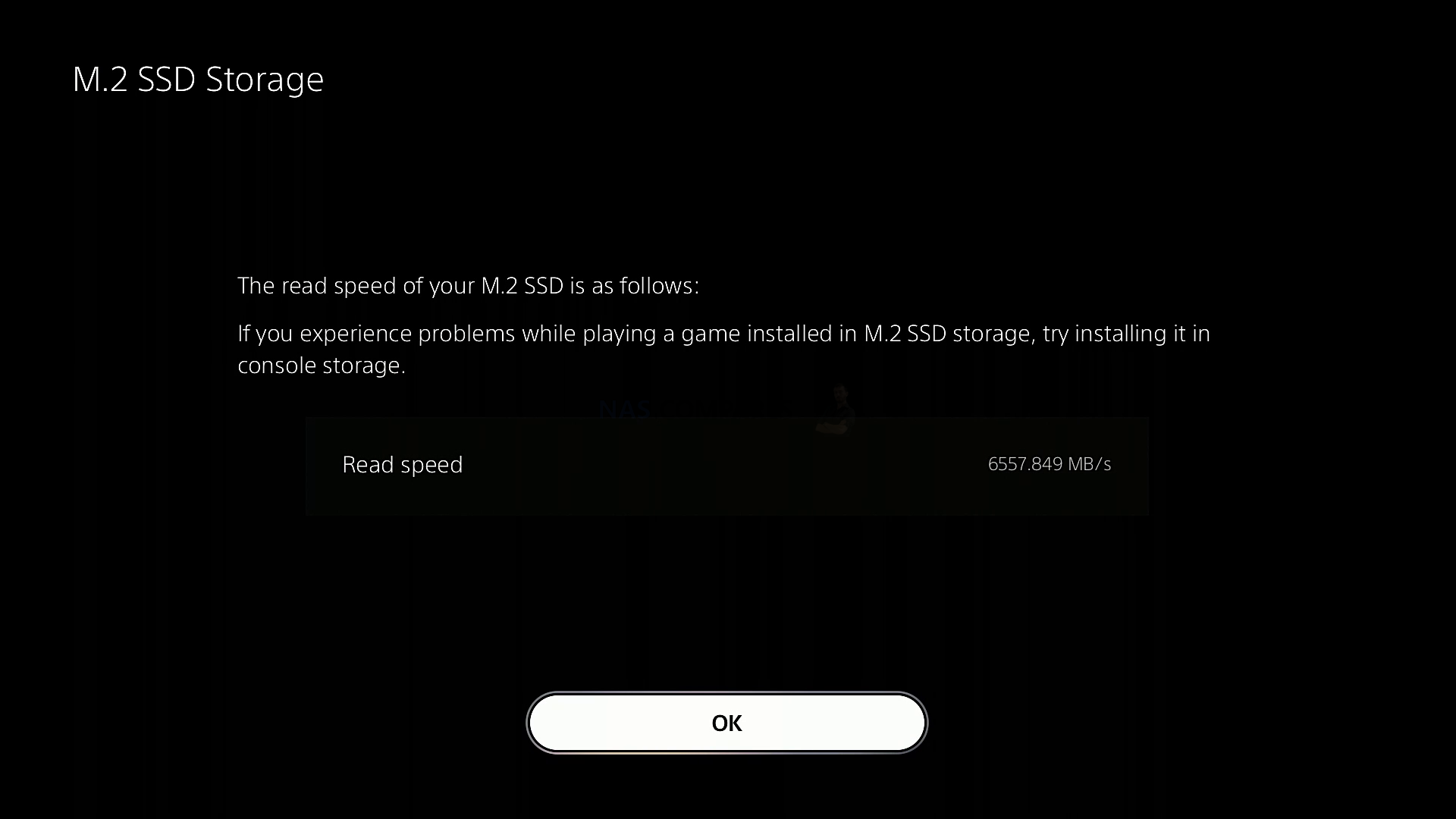 |
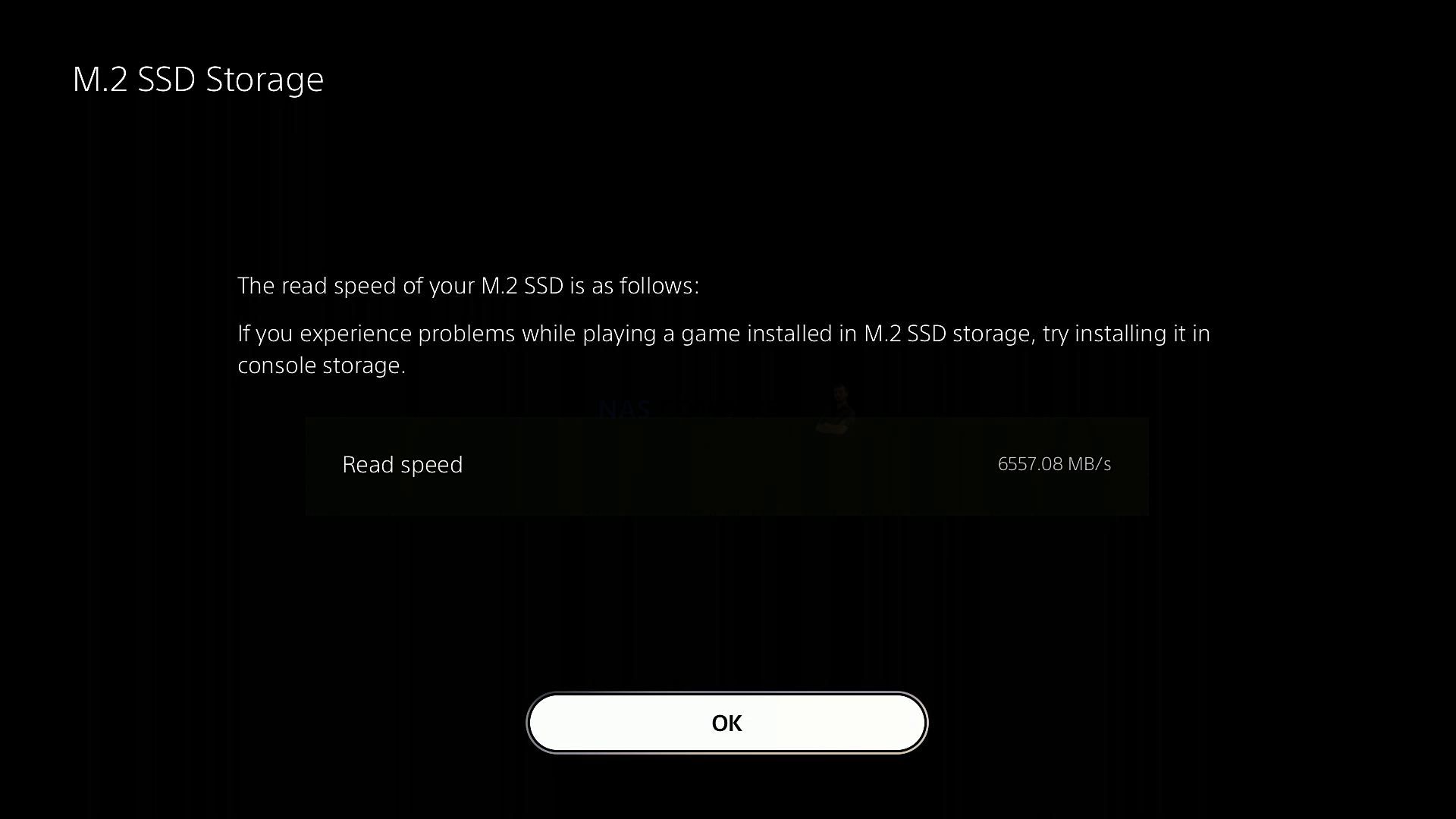 |
| Sabrent Rocket 4 Plus – 6557MB/s | Gigabyte Aorus 7000s PS5 Benchmark – 6557MB/s |
Full PS5 Testing of this is all available as a playlist over on the NASCompares YouTube channel. But for now, let’s carry on with looking at the hardware of the A440, how it conventionally benchmarks and how it compares with currently favourite PS5 SSDs like the WD Black and Seagate Firecuda 530,
So that is the physical design of the Corsair MP600 PRO LPX SSD. But what about the hardware components themselves? Does the Corsair MP600 PRO LPX cut the mustard in terms of current generation hardware and protocols? Let’s find out. First thing’s first, let’s remove the heatsink of the Corsair MP600 PRO LPX, which is done by the removal of four individual Phillips head screw heads. Also, don’t do this! It will invalidate your warranty.
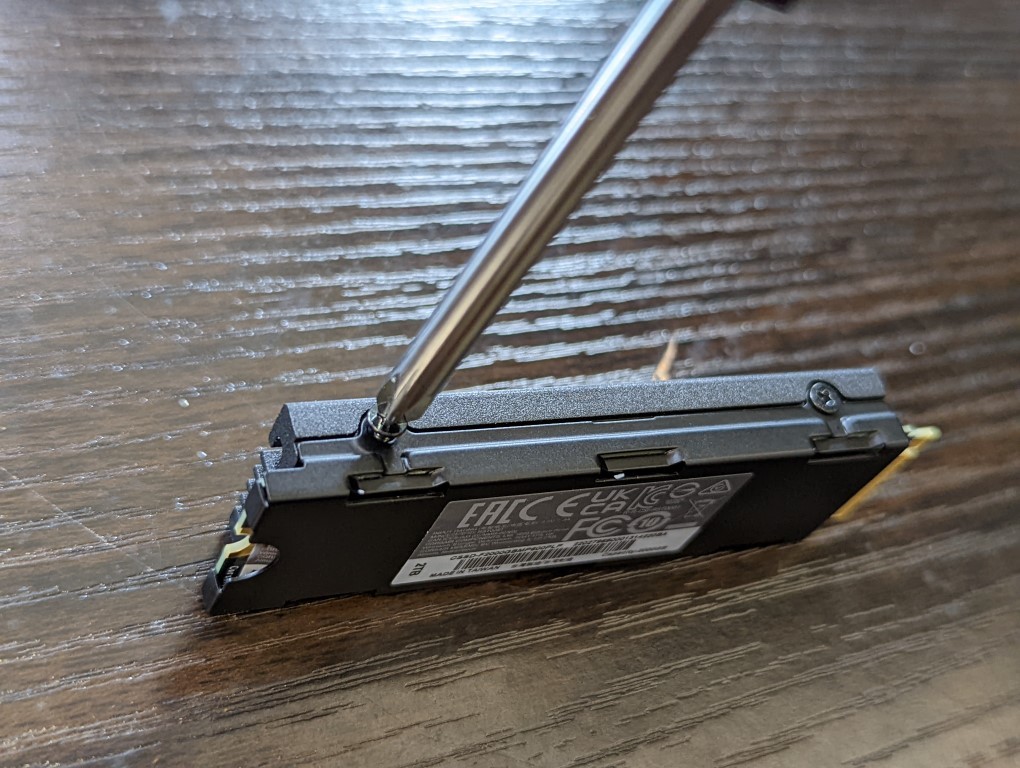
Inside, we find thermal paste/gel applied directly onto the key components. This SSD was a 2-sides PCB (8x 256GB NAND) and thermal material was applied on either side. I expected to see a rectangular thermal pad, but this direct application onto the key components is arguably better (more precisely on the controller). Let’s discuss the main components and architecture of this SSD:
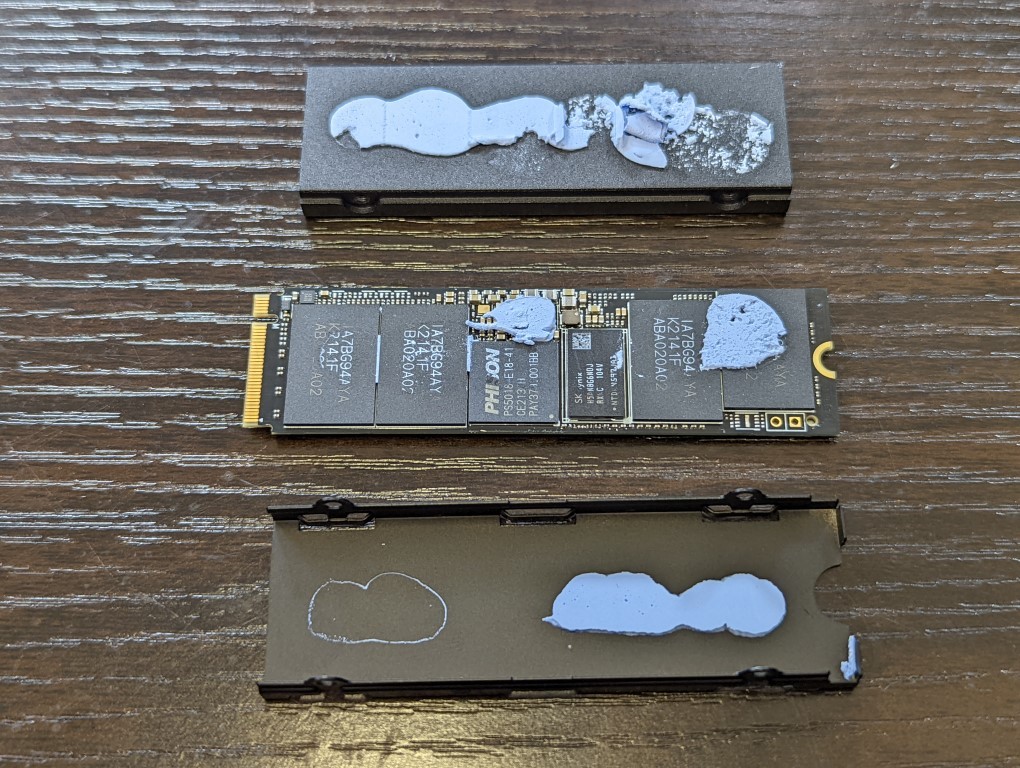
Corsair MP600 PRO LPX SSD Review – Hardware Specifications
As you might expect from an M.2 NVMe SSD that boldly promises performance of over 7,000MB/s sequential read (ie BIG data), the hardware specifications and architecture of the Corsair MP600 PRO LPX are quite modern. Indeed, for all the big talk of the incredibly similar Seagate Firecuda 530 hardware (still currently the ‘score to beat’ PCIE Gen4 m.2 NVMe right now, though a noticeable degree more expensive than all the others) being top tier, the Corsair MP600 PRO LPX is pretty darn similar on the spec sheet! Below is how it looks:
| Corsair MP600 PRO LPX
|
|
| PCIe Generation | PCIe 4 x4 |
| NVMe Rev | NVMe Rev. 1.4 |
| NAND & Memory | 176L 3D TLC Micron B47R |
| Max Capacity | 1-4TB |
| Controller | Phison PS5018-E18 |
| Warranty | 5 Years |
I know a lot of the above will seem needlessly technical, so below we can bring the most important considerations into sharper focus.
Hardware Focus of the Corsair MP600 PRO LPX SSD Series
The first big, BIG thing to remember here is the controller, that Phison E18. An SSD is much like a microcosm version of a whole computer. The Controller is equivalent to the CPU, and Phison are one of the bigger 3rd party SSD controller manufacturers in the world! I say 3rd party because some long-running storage brands like Samsung and WD have most of their development and hardware engineering ‘in-house’ and use their own branded controllers. Whereas some brands source some/all components for their SSDs from 3rd parties – which is not necessarily a bad thing for both them and the industry (there are pros and cons on either side). Phison has been at the cutting edge of this subject for years now and the E18 was first revealed last year in 2020, but due to the pandemic making storage trends unpredictable and semi-conductor shortages, most SSDs that utilized the Phison E18 eventually arrived in 2021. This controller is one of the biggest reasons that the Corsair MP600 PRO LPX can actually back up it’s promises about the 7,000MB/s+ (reporting a max 7,100) Sequential Read (sequential data = big chunks of data). However, that is not the only reason.
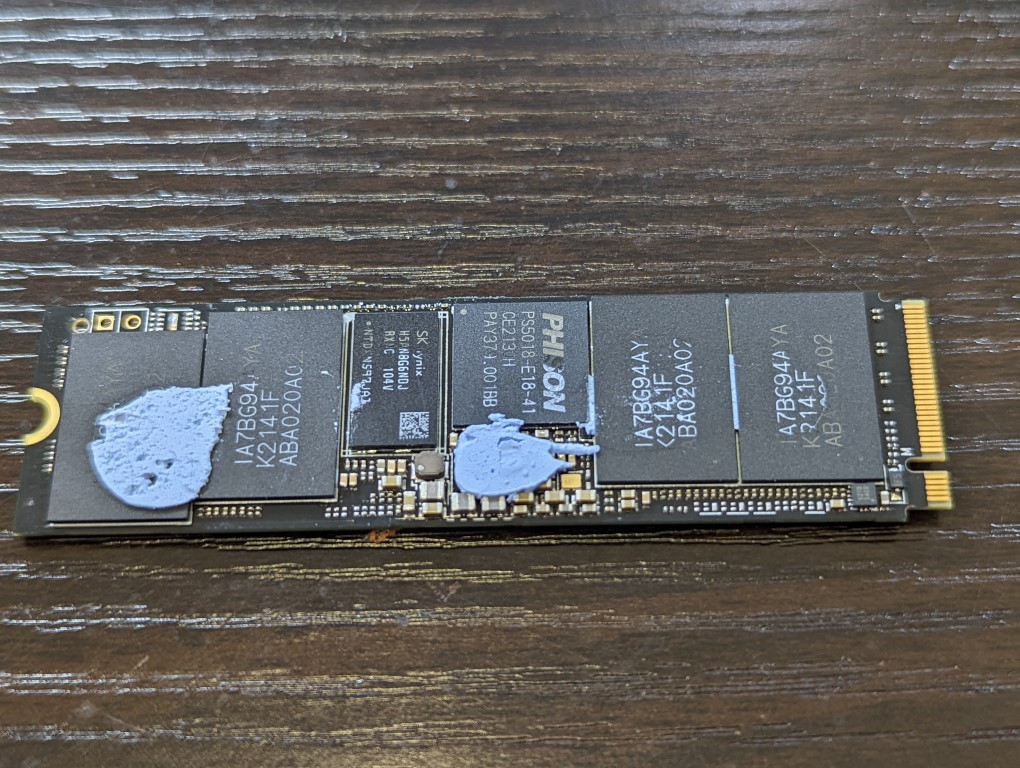
The NAND on the Corsair MP600 PRO LPX is where the data lives! SSDs (as you no doubt know) do not use moving parts as found in traditional hard drives and instead uses cells that are charged and data is read/written to them in this process. The quality of the NAND and the layers used will make a big difference to the durability and performance of an SSD and the Corsair MP600 PRO LPX features the same NAND quality as the Seagate Firecuda 530 at 176 layer 3D TLC NAND), which is bigger than most, arriving at 96 Layers of 3D TLC NAND. Although the majority of modern PCIe M.2 SSD use 3D TLC NAND (avoid QLC NAND like the PLAGUE btw!), most are still at 96 layers or so, which still puts the Corsair MP600 PRO LPX SSD ahead.
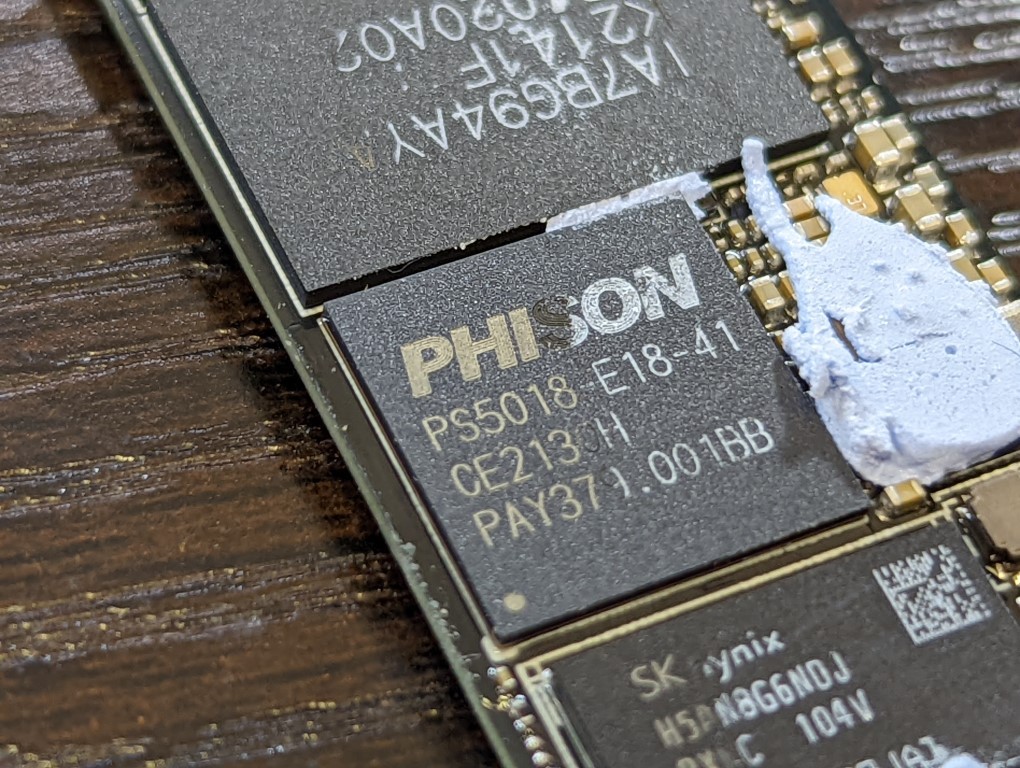
Much like the Controller on the Corsair MP600 PRO LPX being the ‘CPU’, it also has an area of memory. The Corsair MP600 PRO LPX SSD uses 2GB DDR4 DRAM/Memory on board and this in conjunction with the SSD provides a massive body of data handling resources for getting your data moving through the SSD and out of the m.2 NVMe PCIe 4 interface. The amount of memory scales in conjunction with the 1TB or 2TB SSD you use, with 2GB of DDR4 at the 2TB tier, 1GB DDR4 on the 1TB, etc.
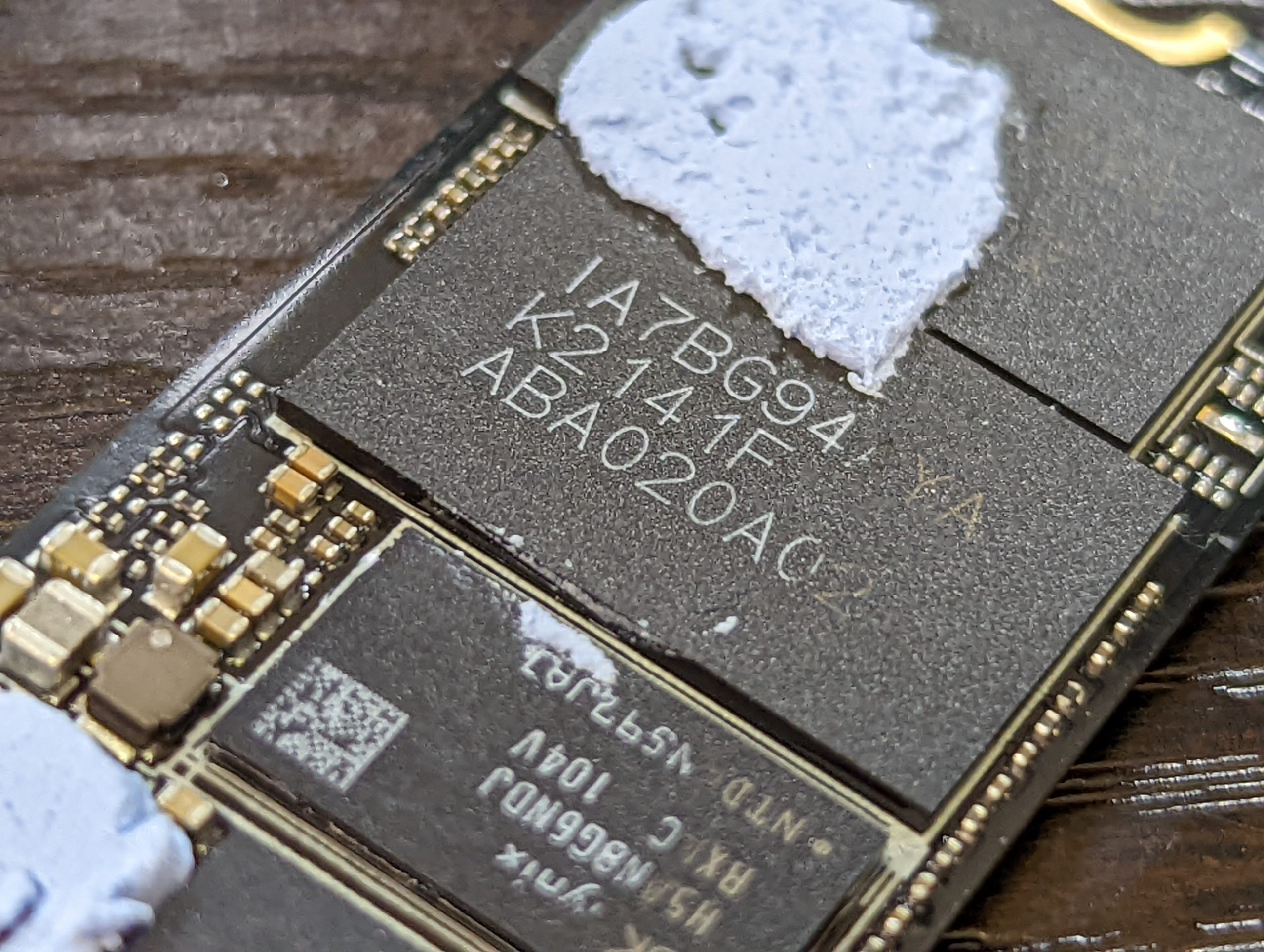
As mentioned, all available capacities of the Corsair MP600 PRO LPX arrive at 2280 in length. The Corsair MP600 PRO LPX range arrives in 500GB, 1TB, 2TB and 4TB, with the latter two choices arriving as double-sided SSDs. Performance increases (less so in Read, but very much in Write) as your scale-up in the capacities and the larger distribution of NAND that can be accessed simultaneously is a big reason for this.
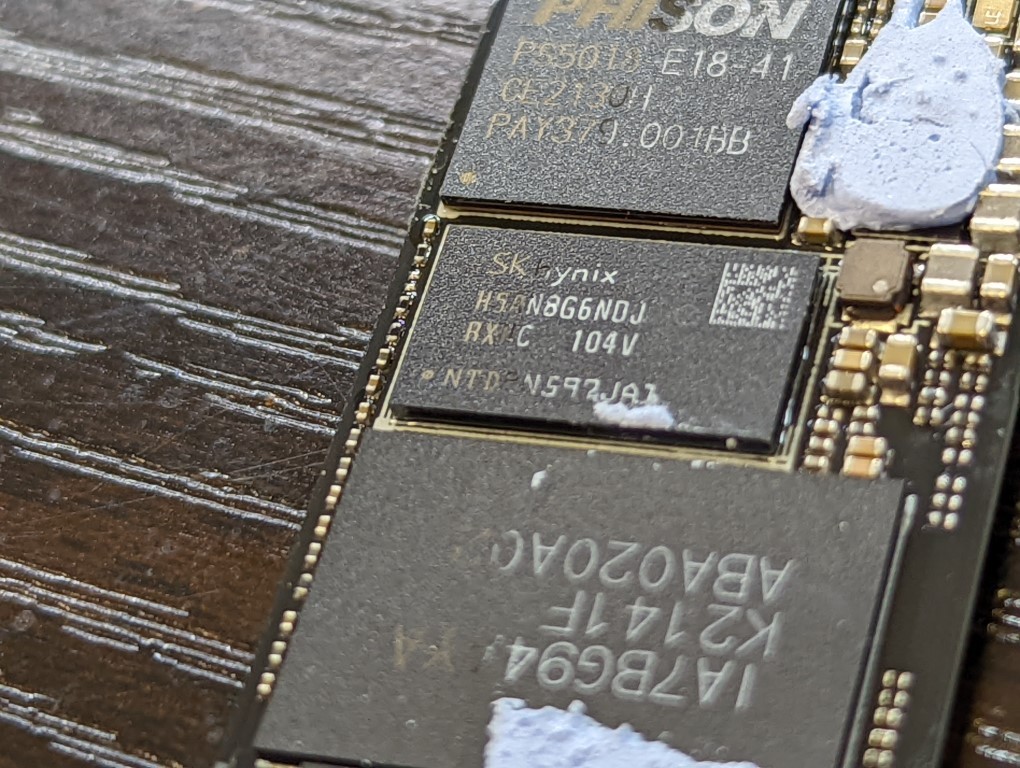
Finally, there is the M.2 NVMe connection. Not all m.2 SSDs are created equal and although M.2 SATA and M.2 NVMe look similar, they provide massively different performance and connectivity. However, the Corsair MP600 PRO LPX takes it one step further, by using a newer generation of PCIe Connectivity. In short, M.2 NVMe SSDs are connected to the host PC/Console system via PCIe protocol (think of those slots that you almost always use for your graphics cards, but a much, MUCH smaller connector). These allow much larger bandwidth (ie maximum speed) for the connected storage media, Much like regular PCIe slots, they have different versions (i.E PCIe Gen 1, 2, 3, 4, etc) and also a multiplying factor (x1, x2, x4, etc). Up until around 18 months ago, the best M.2 NVMes were M.2 PCIe Gen 3×4 (so a maximum 4,000MB/s possible). However, never generation SSD like the Corsair MP600 PRO LPX use PCIe Gen 4×4 (a potential 8,000MB/s possible) and it is only now that SSD controllers and NAND production has reached a point where it can catch up and fully saturate (i.e fill) this connection.
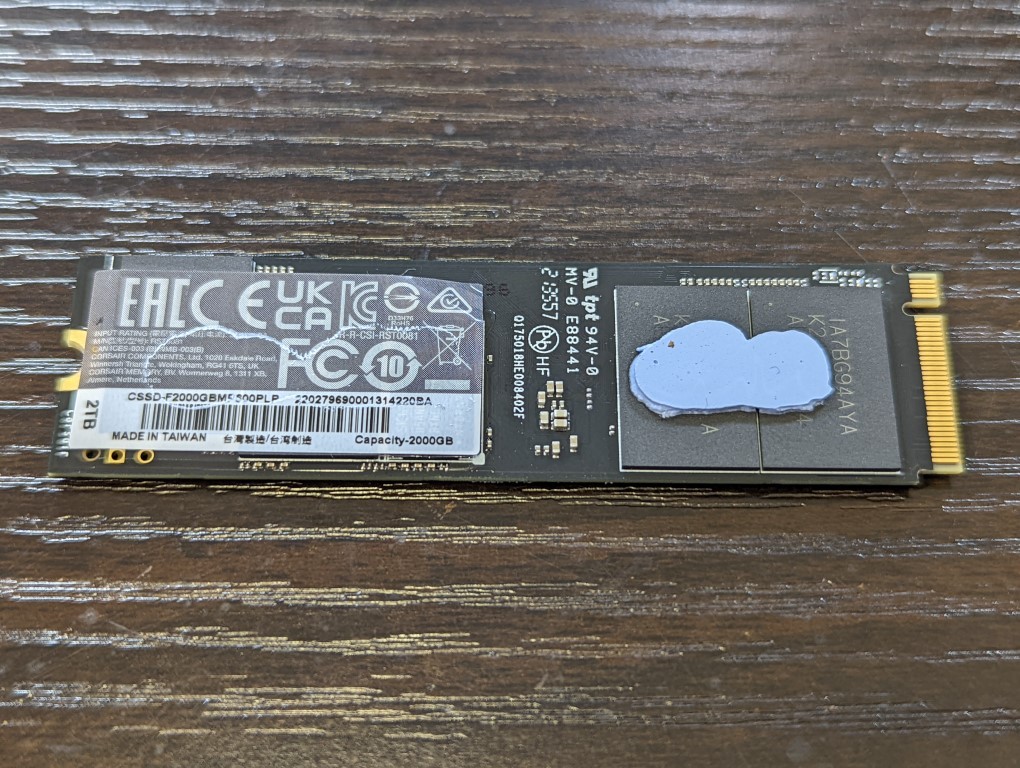
Overall, you really cannot fault the hardware inside/onboard the Corsair MP600 PRO LPX, as it is still higher performing in sequential Read and Write than many other M.2 NVMe PCIe 4 SSDs released in that time. Before we go into the full testing, however, it is worth taking a moment to look closely at the reported performance benchmarks of the Corsair MP600 PRO LPX, as although the performance seems stellar, there are areas such as IOPS and endurance when compared with its main rivals that are worth taking into consideration.
Corsair MP600 PRO LPX SSD Review – Official Stats First
Before we conduct our own testing on this SSD, Let’s take a closer look at the reported specifications and benchmarks first. The Corsair MP600 PRO LPX SSD arrives in multiple capacities (below). The Prices currently are a little inconsistent (with each higher capacity tier actually having a higher price per GB – quite unusual) likely due to the hardware shortages, the Pandemic, Chia has affected SSD availability in the last 12 months and most recently the announcement that PS5 supports this SSD and it has increased the current price of both models around 20-30%! That said, the Corsair MP600 PRO LPX arrives at a price point that undercuts the Seagate and even challenges popular SSDs in the market from WD and Samsung, despite being the newest SSD on the scene. Below is a breakdown of how each Corsair MP600 PRO LPX SSD compares:
| Brand/Series | Corsair MP600 PRO LPX
|
Seagate Firecuda 530
500GB – $149.99, 1TB – $239.99, 2TB – $489.99, 4TB – $949.99 |
WD Black SN850
|
| PCIe Generation | PCIe Gen 4 | PCIe Gen 4 | PCIe Gen 4 |
| NVMe Rev | NVMe 1.4 | NVMe 1.4 | NVMe 1.4 |
| NAND | 176L 3D TLC Micron B47R | 3D TLC Micron B47R 176L | BiCS4 96L TLC |
| Max Capacity | 4TB – Double Sided | 4TB – Double Sided | 2TB |
| Controller | Phison E18-PS5018 | Phison E18-PS5018 | WD_BLACK G2 |
| Warranty | 5yr | 5yr | 5yr |
| 500GB Model | CSSD-F0500GBMP600PLP | ZP500GM3A013 | WDS500G1X0E-00AFY0 |
| Price in $ and $ | $99 | $139 / £119 | $119 / £99 |
| 1TB Model | CSSD-F01000GBMP600PLP | ZP1000GM3A013 | WDS100T1X0E-00AFY0 |
| Price in $ and $ | $169 / £169 | $239 / £199 | $249 / £169 |
| 2TB Model | CSSD-F02000GBMP600PLP | ZP2000GM3A013 | WDS200T1X0E-00AFY0 |
| Price in $ and $ | $339 / £289 | $419 / £379 | $399 / £339 |
| 4TB Model | CSSD-F04000GBMP600PLP | ZP4000GM3A013 | N/A |
| Price in $ and $ | $749 / £699 | $949 / £789 | N/A |
| 500GB Model | CSSD-F0500GBMP600PLP | ZP500GM3A013 | WDS500G1X0E-00AFY0 |
| Total Terabytes Written (TBW) | 350TB | 640TB | 300TB |
| Mean Time Between Failures (MTBF, hours) | 1,600,000 | 1,800,000 | 1,750,000 |
| DWPD | 0.38 | 0.7DWPD | 0.3DWPD |
| 1TB Model | CSSD-F01000GBMP600PLP | ZP1000GM3A013 | WDS100T1X0E-00AFY0 |
| Total Terabytes Written (TBW) | 700TB | 1275TB | 600TB |
| Mean Time Between Failures (MTBF, hours) | 1,600,000 | 1,800,000 | 1,750,000 |
| DWPD | 0.38DWPD | 0.7DWPD | 0.3DWPD |
| 2TB Model | CSSD-F02000GBMP600PLP | ZP2000GM3A013 | WDS200T1X0E-00AFY0 |
| Total Terabytes Written (TBW) | 1400TB | 2550TB | 1200TB |
| Mean Time Between Failures (MTBF, hours) | 1,600,000 | 1,800,000 | 1,750,000 |
| DWPD | 0.38DWPD | 0.7DWPD | 0.3DWPD |
| 4TB Model | CSSD-F04000GBMP600PLP | ZP4000GM3A013 | N/A |
| Total Terabytes Written (TBW) | 2800TB | 5100TB | N/A |
| Mean Time Between Failures (MTBF, hours) | 1,600,000 | 1,800,000 | N/A |
| DWPD | 0.38DWPD | 0.7DWPD | N/A |
There are clear throughput improvements as you rise through the capacity tiers (not unusual), as does the rated 4K IOPS. Though one area worth focusing on a little is that TBW (terabytes Written) and DWPD (Drive writes per day), as this drive is rated a pinch higher than the Samsung 980 Pro and WD Black SN850 in terms of NAND lifespan on daily writes, likely down to that Micron 176 Layer 3D TLC NAND used, rather than t used by those used by competitors. This is an important point because the brand has significantly less pedigree in-home/business SSD media than the likes of Samsung, WD and Seagate and people will want to know they are going to get a product that lasts!
Additionally, thanks to the use of the Phison E18 controller and 176 layer NAND, the reported IOPS on each capacity is actually a noticeable degree higher than those reported by their competitors. Indeed, the Corsair MP600 PRO LPX is one of the few E18 SSDs that does not state it’s reported 4K random IOPS on the official pages,so it does make me wonder where the disparity stems from. Indeed, when you look at the bulk of PCIe 4×4 M.2 NVMe 1.4 SSD, that feature the E18 controller and 96L (or higher) on board, it really leaves about 10 other SSDs in the market today that this can be compared against, such as the Sabrent Rocket 4 Plus, the MSI Spatium M480, the ADATA Gammix S70 and (current leader) the Seagate Firecuda 530. Of those, the only one that seemingly ‘out specs’ the Corsair MP600 PRO LPX is the Seagate Firecuda 530. However, the Corsair MP600 PRO LPX SSD has been available in the market for mere weeks at the time of writing and has certainly embedded itself in the market at that time a fraction more. Below is how these two drives compare:
| Brand/Series | Corsair MP600 PRO LPX
|
Seagate Firecuda 530
500GB – $149.99, 1TB – $239.99, 2TB – $489.99, 4TB – $949.99 |
WD Black SN850
|
| 500GB Model | CSSD-F0500GBMP600PLP | ZP500GM3A013 | WDS500G1X0E-00AFY0 |
| Sequential Read (Max, MB/s), 128 KB | 7100MB | 7000MB | 7000MB |
| Sequential Write (Max, MB/s), 128 KB | 3700MB | 3000MB | 4100MB |
| 1TB Model | CSSD-F01000GBMP600PLP | ZP1000GM3A013 | WDS100T1X0E-00AFY0 |
| Sequential Read (Max, MB/s), 128 KB | 7100MB | 7300MB | 7000MB |
| Sequential Write (Max, MB/s), 128 KB | 5800MB | 6000MB | 5300MB |
| 2TB Model | CSSD-F02000GBMP600PLP | ZP2000GM3A013 | WDS200T1X0E-00AFY0 |
| Sequential Read (Max, MB/s), 128 KB | 7100MB | 7300MB | 7000MB |
| Sequential Write (Max, MB/s), 128 KB | 6800MB | 6900MB | 5100MB |
| 4TB Model | CSSD-F04000GBMP600PLP | ZP4000GM3A013 | |
| Sequential Read (Max, MB/s), 128 KB | 7100MB | 7300MB | N/A |
| Sequential Write (Max, MB/s), 128 KB | 6800MB | 6900MB | N/A |
| Brand/Series | Seagate Firecuda 530 | WD Black SN850 | |
| 500GB Model | CSSD-F0500GBMP600PLP | ZP500GM3A013 | WDS500G1X0E-00AFY0 |
| Random Read (Max, IOPS), 4 KB QD32 | 435,000 | 400,000 | 1,000,000 |
| Random Write (Max, IOPS), 4 KB QD32 | 615,000 | 700,000 | 680,000 |
| 1TB Model | CSSD-F01000GBMP600PLP | ZP1000GM3A013 | WDS100T1X0E-00AFY0 |
| Random Read (Max, IOPS), 4 KB QD32 | 900000 | 800000 | 1,000,000 |
| Random Write (Max, IOPS), 4 KB QD32 | 1,200,000 | 1000000 | 720,000 |
| 2TB Model | CSSD-F02000GBMP600PLP | ZP2000GM3A013 | WDS200T1X0E-00AFY0 |
| Random Read (Max, IOPS), 4 KB QD32 | 1,000,000 | 1,000,000 | 1,000,000 |
| Random Write (Max, IOPS), 4 KB QD32 | 1,200,000 | 1,000,000 | 710,000 |
| 4TB Model | CSSD-F04000GBMP600PLP | ZP4000GM3A013 | |
| Random Read (Max, IOPS), 4 KB QD32 | 1,000,000 | 1,000,000 | N/A |
| Random Write (Max, IOPS), 4 KB QD32 | 1,200,000 | 1,000,000 | N/A |
Yes, that is a LONG table, but you can immediately see that the Seagate Firecuda 530 raises the stakes on all of the key specifications. Although there are a number of micro reasons for this, the 176L NAND is the biggest factor here, but also that EK designed heatsink and inclusive data recovery services. Yes, that is why the Firecuda 530 commands a higher price tag. Additionally, the WD Black arrives at a better price point, solid IOPS in most tiers and the fact it does this whilst still hitting that 7,000MB/s certainly gives pause for thought. However, for many, the additional cost for higher durability they may never need, peak performance their core system will not reach and IOPS rating that their larger file handling will never utilize will mean that holding out for the Firecuda or WD Black SN850 is not in their interest. Both SSDs (on paper at this stage!) are fantastic examples of where consumer and prosumer SSDs are evolving towards. Let’s get the Corsair MP600 PRO LPX on the test machine!
Testing the Corsair MP600 PRO LPX m.2 PCIE4 NVMe SSD
The Corsair MP600 PRO LPX was selected for this test and it was tested using multiple benchmark tools, from a cold boot, in the 2nd storage slot (i.e not the OS drive). Each test was conducted three times (full details of this are shown in the YouTube Review of the Corsair MP600 PRO LPX over on NASCompares):
Test Machine:
- Windows 10 Pro Desktop System
- Intel i5 11400 Rocket Lake – 6-Core 2.6/4.4Ghz
- 16GB DDR4 2666MHz Memory
- Intel B560M mATX Motherboard
- OS Storage, Seagate Firecuda 120 SSD
- Test SSD connected to Secondary PCIe Gen 4 M.2 Slot
Once again, it is worth looking at the temperatures that this SSD hit during the testing. 1 minute cooldown was provided between tests and although the SSD clearly dissipated heat effectively, it still maintained a comparatively high temp during the tests.
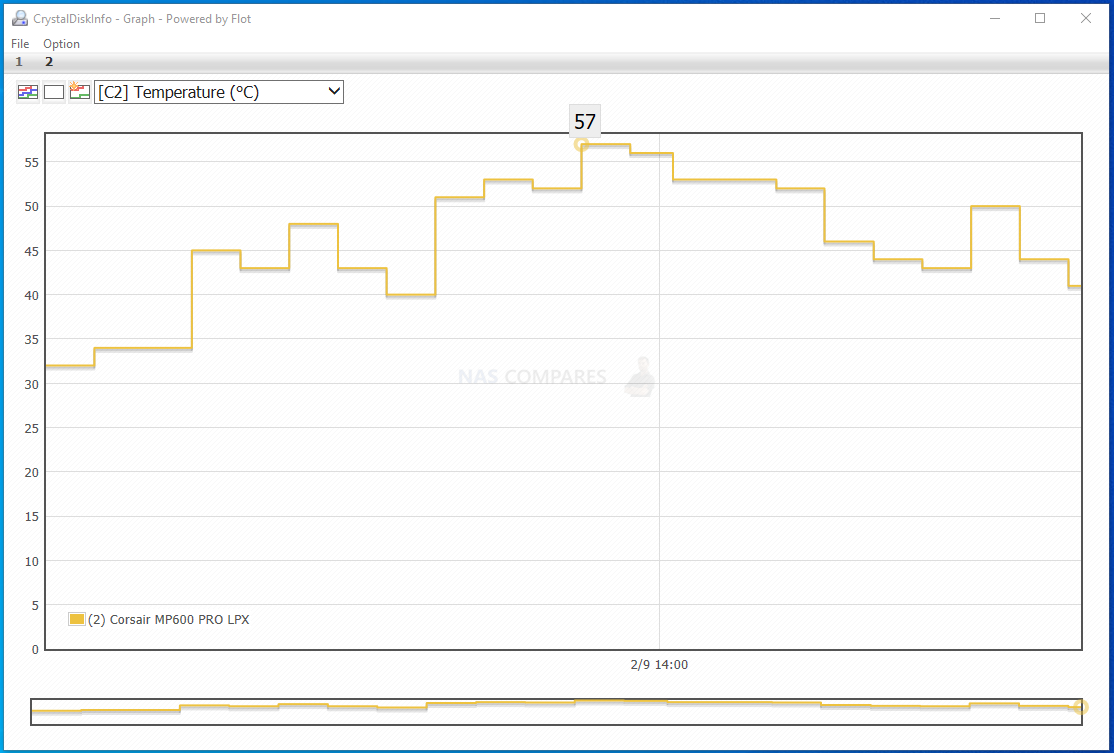
Using CrystalDisk, we got a good measure of the drive and verified that this PCIe Gen 4 x4 SSD was indeed using the 4×4 lane. Additionally, the temp averaged out around 47C between each test being conducted.
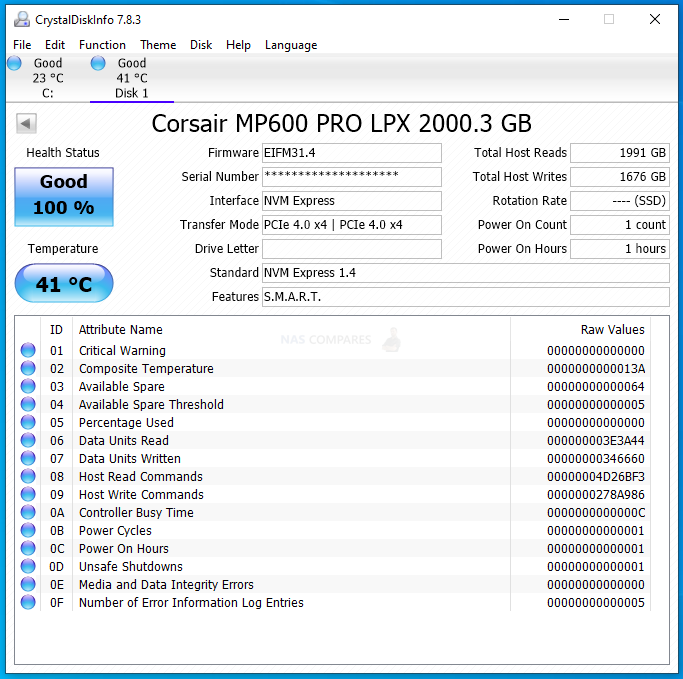
The first tests were conducted using the ATTO disk benchmark software. The first was a 256MB test file size and below is a breakdown of the transfer rates and IOPS. The 2nd Test was a 1GB test file and finally, the last test was with a 4GB test file. The system was given 1-minute cool downtime between tests, no screen recording software was used (remove overhead) and a heatsink was used throughout (no reboots)
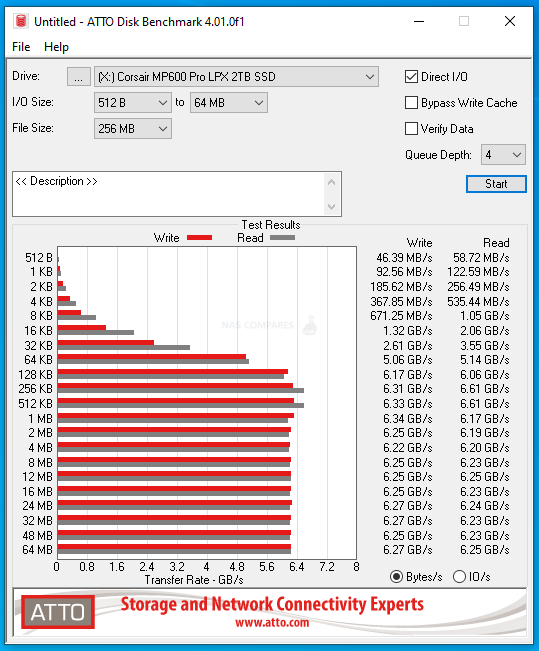 |
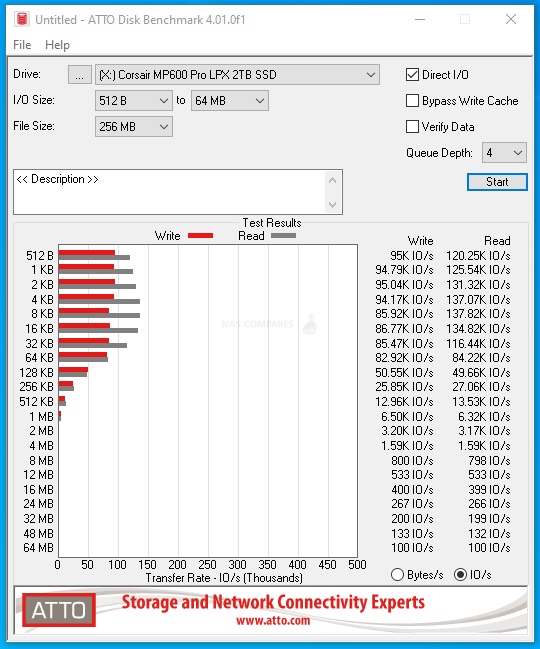 |
ATTO Disk Benchmark Test #1
256MB File PEAK Read Throughput = 6.61GB/s
256MB File PEAK Write Throughput = 6.34GB/s
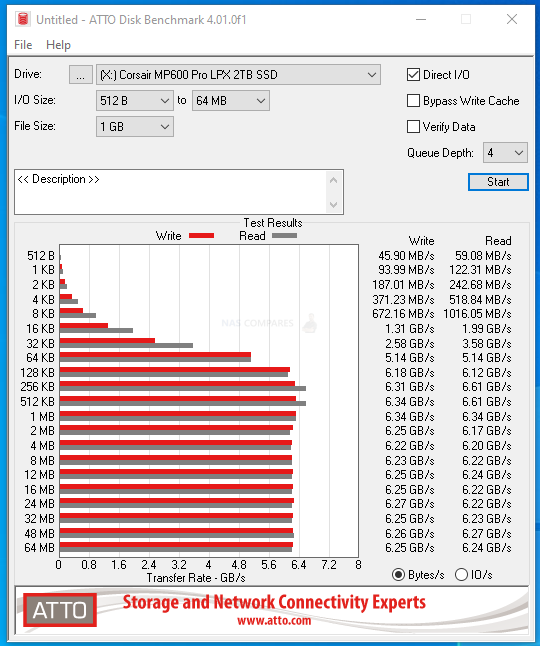 |
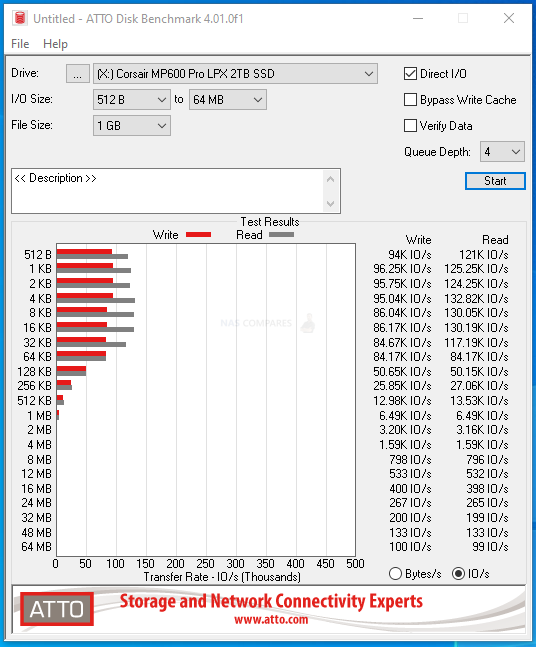 |
ATTO Disk Benchmark Test #2
1GB File PEAK Read Throughput = 6.61GB/s
1GB File PEAK Write Throughput = 6.34GB/s
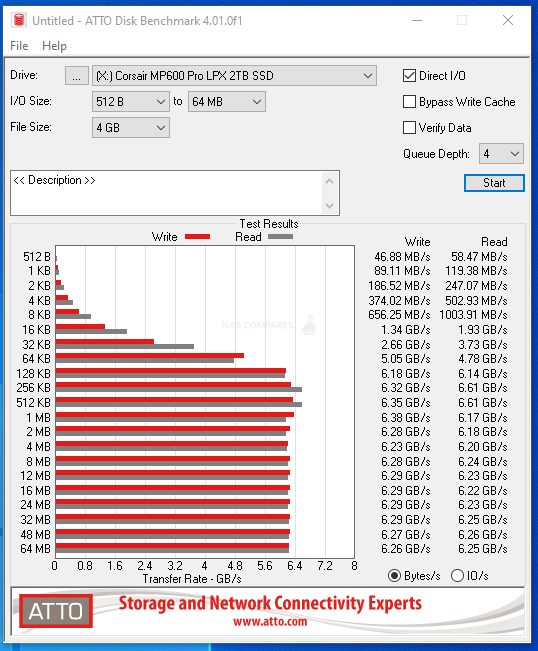 |
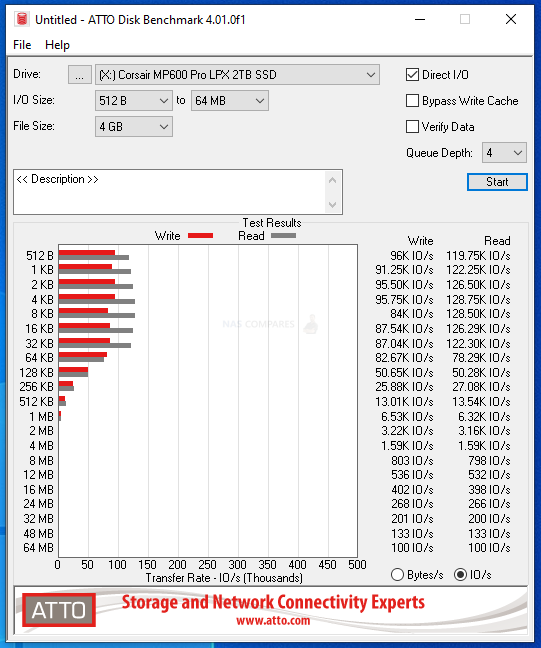 |
ATTO Disk Benchmark Test #3
4GB File PEAK Read Throughput = 6.61GB/s
4GB File PEAK Write Throughput = 6,.38GB/s
Next, although the ATTO tests were quite good, but not what I would have hoped from this SSD, so I moved on to the Crystal Disk Mark testing to see how well it would handle our last barrage of tests. The first test was the 1GB file testing, which measured both sequential and random, as well as the read and write IOPS. Tests were conducted on a 1GB, 4GB and 16GB Test File. I also included a mixed 70/30 read and write task to give a little bit more of a realistic balanced workload. These tests were conducted with 1-minute cooling break in between
CRYSTALDISK MARK 1GB TEST
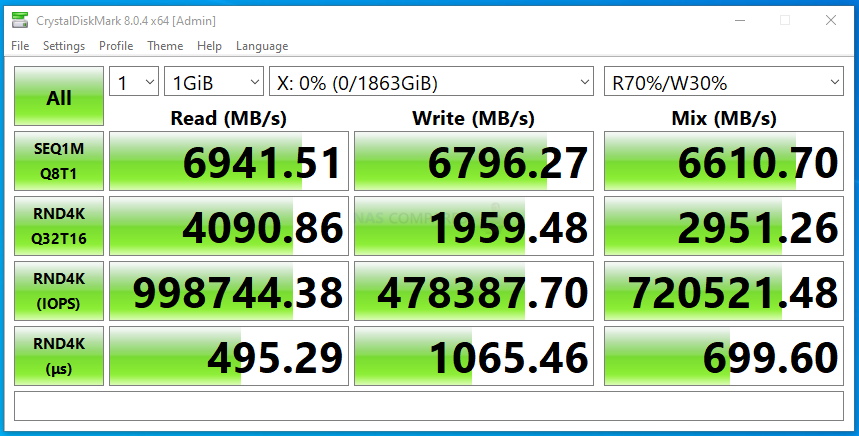
CRYSTALDISK MARK 4GB TEST
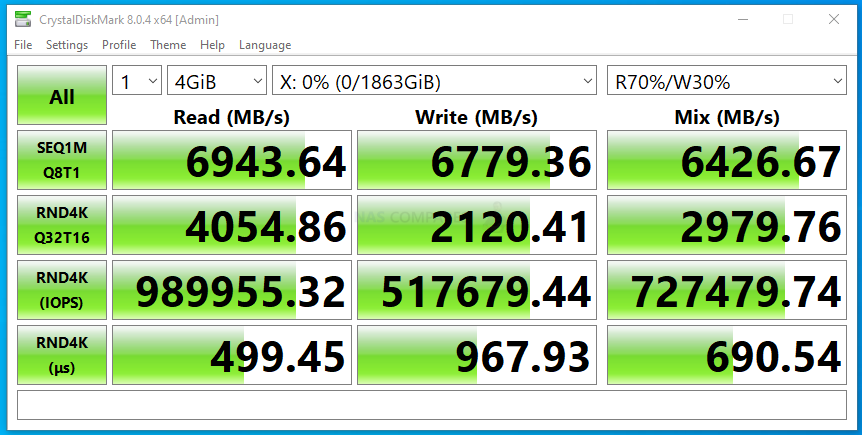
CRYSTALDISK MARK 16GB TEST
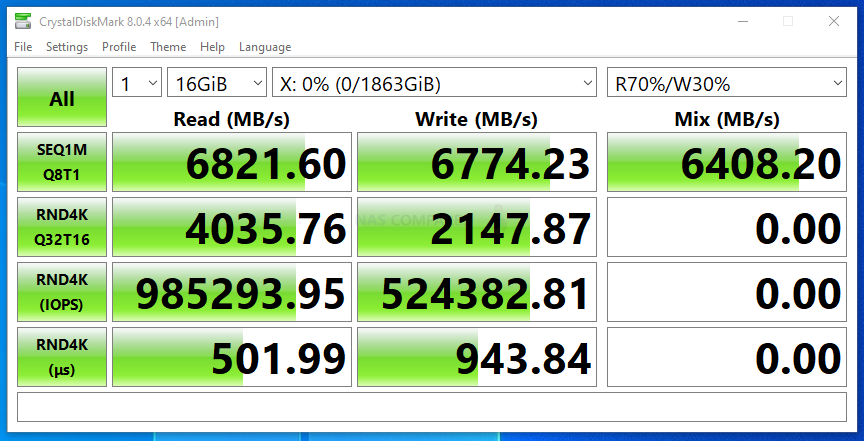
Next, I switched to AS SSD benchmark. A much more thorough test through, I used 1GB, 3GB and 5GB test files. Each test includes throughput benchmarks and IOPS that are respective to the larger file sizes (important, if you are reading this and trying to compare against the reported 4K IOPS from the manufacturer).
AS SSD Benchmark Test #1
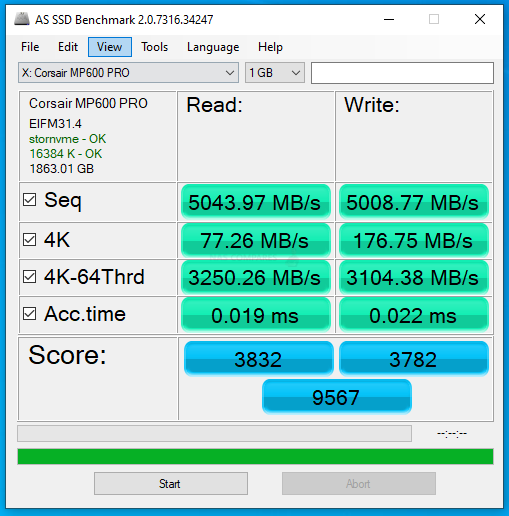 |
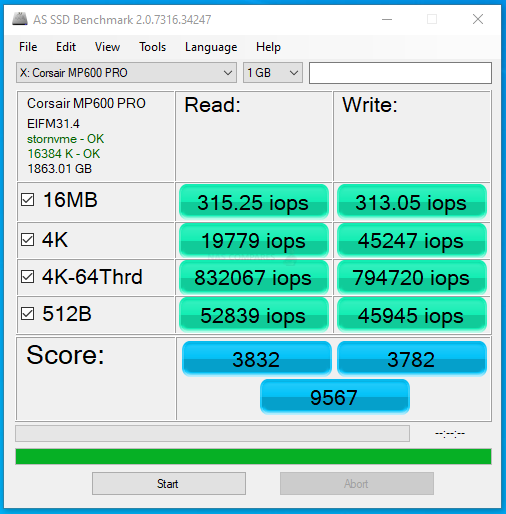 |
AS SSD Benchmark Test #2
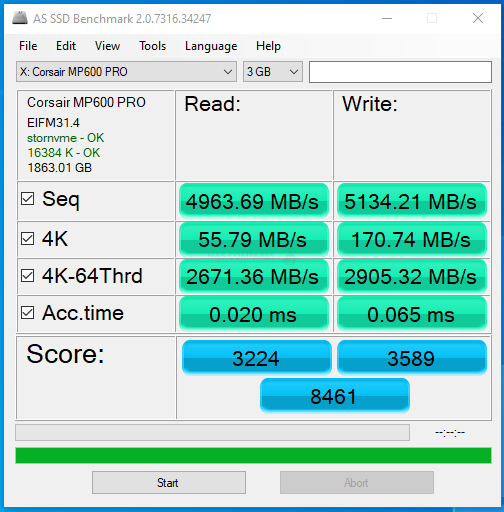 |
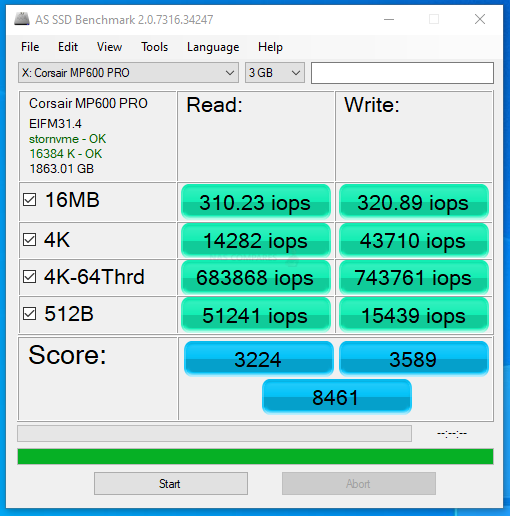 |
AS SSD Benchmark Test #3
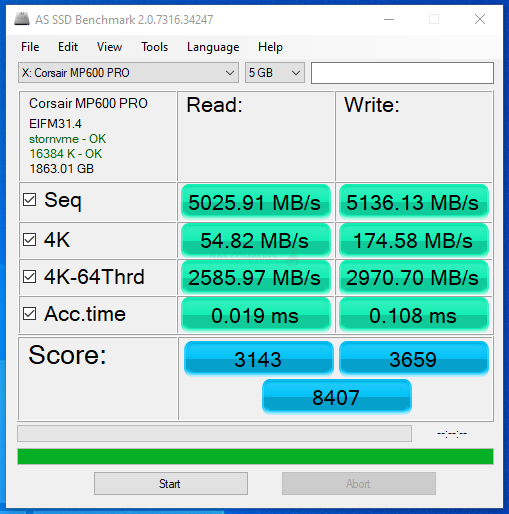 |
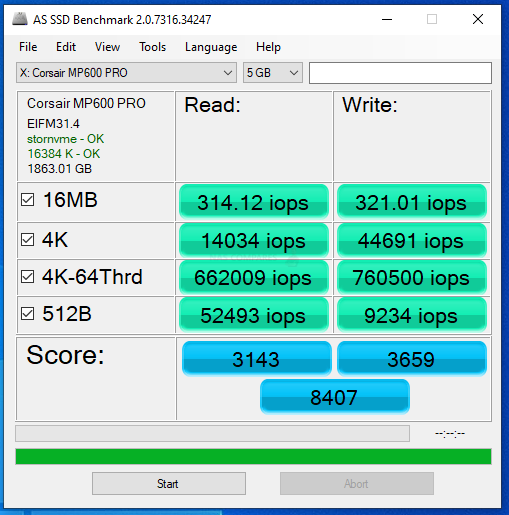 |
Ordinarily, I would introduce tests like BlackMagic and AJA into the mix here, but even a short burst of testing on an NVMe like this would over saturate the cache memory on board. Nevertheless, in the short term we still could ascertain the reported performance on 1GB, 4GB and 16GB file testing was:
1GB AJA File Test Results (Peak) = 5835MB/s Read & 5648MB/s Write

4GB AJA File Test Results (Peak) = 5816MB/s Read & 5678MB/s Write

16GB AJA File Test Results (Peak) = 6035MB/s Read & 5547MB/s Write

Overall, the Corsair MP600 PRO LPX was certainly able to provide some solid performance, as well as potentially exceed the test figures here on a more powerful machine. Given the reported Read and Write statistics that the brand has stated publically, I think there is enough evidence here to back up those claims. IOPs were a little lower than I expected (I hoped to see them cross into the 1Million mark), but again, we were testing very large file types, so this would have to be taken in context.
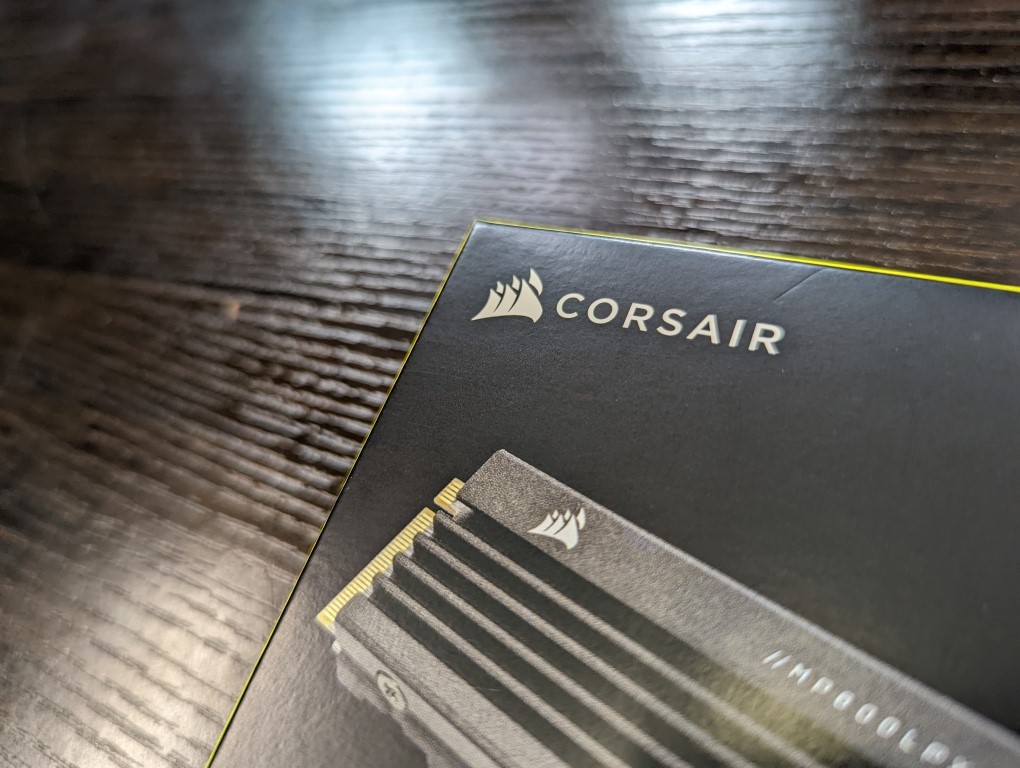
Corsair MP600 PRO LPX SSD Review – Conclusion
Arriving as a slight change on the blueprints of the previously released Corsair MP600 Pro, the newly PS5 optimized Corsair MP600 Pro LPX is very much a second helping of what that same SSD did previously. It does bring a few tweaks into the mix (modified Heatsink, improved NAND, etc) but if you are already an owner of the PC focused MP600 Pro, there isn’t going to be much new for you here. However, if this is your first time considering the Corsair MP600 Pro LPX as your gamer SSD of course, is it a remarkably solid, well built and understated piece of storage! Performing remarkably well in testing on the PC and PS5, this IS a good SSD. That said, the PCIe Gen 4 SSD market is fast becoming a very crowded place and despite its pluses, the Corsair MP600 Pro LPX may be in danger of fading into the background. Luckily its pricing appears more dynamic than many out there (even at its launch) and the Corsair name carries enough kudos in the PC market to get picked up by console gamers nonetheless. A good SSD that, had it been released just 6 months before, I think would have made a bigger noise for buyers to hear! PS5 Buyers, don’t hesitate! PC buyers, maybe save a few quid and opt for the MP600 Pro standard version.
| PROs of the Corsair MP600 PRO LPX | CONs of the Corsair MP600 PRO LPX |
| Another good Phison E18 SSD
Same Architecture (inc NAND quality) to the Seagate Firecuda 530 Good Price Point vs WD & Seagate Options Genuinely Impressive value for the price tag PS5 Compatibility is Confirmed and the heatsink fits great No overpromising of its abilities and solid performance Durability is a pinch better than the WD Black SN850 and Samsung 980 Pro Higher 4K Random IOPS ratings than most Impressively high write performance compared with similar architecture SSD |
The retail package is a little underwhelming
Ran a little hotter than most SSDs in PC benchmark tests |
🔒 Join Inner Circle
Get an alert every time something gets added to this specific article!
This description contains links to Amazon. These links will take you to some of the products mentioned in today's content. As an Amazon Associate, I earn from qualifying purchases. Visit the NASCompares Deal Finder to find the best place to buy this device in your region, based on Service, Support and Reputation - Just Search for your NAS Drive in the Box Below
Need Advice on Data Storage from an Expert?
Finally, for free advice about your setup, just leave a message in the comments below here at NASCompares.com and we will get back to you. Need Help?
Where possible (and where appropriate) please provide as much information about your requirements, as then I can arrange the best answer and solution to your needs. Do not worry about your e-mail address being required, it will NOT be used in a mailing list and will NOT be used in any way other than to respond to your enquiry.
Need Help?
Where possible (and where appropriate) please provide as much information about your requirements, as then I can arrange the best answer and solution to your needs. Do not worry about your e-mail address being required, it will NOT be used in a mailing list and will NOT be used in any way other than to respond to your enquiry.

|
 |
Minisforum N5 NAS, 6 Months Later - Better, Worse, the Same?
Beelink ME Pro NAS Revealed
Best SOLID STORAGE NAS of 2025
Should You Worry About the NanoKVM Hidden Microphone?
Best Cheap NAS of 2025
Minisforum MS-02 Ultra - WHO IS THIS FOR??? (The First 48HRs)
Access content via Patreon or KO-FI





Discover more from NAS Compares
Subscribe to get the latest posts sent to your email.


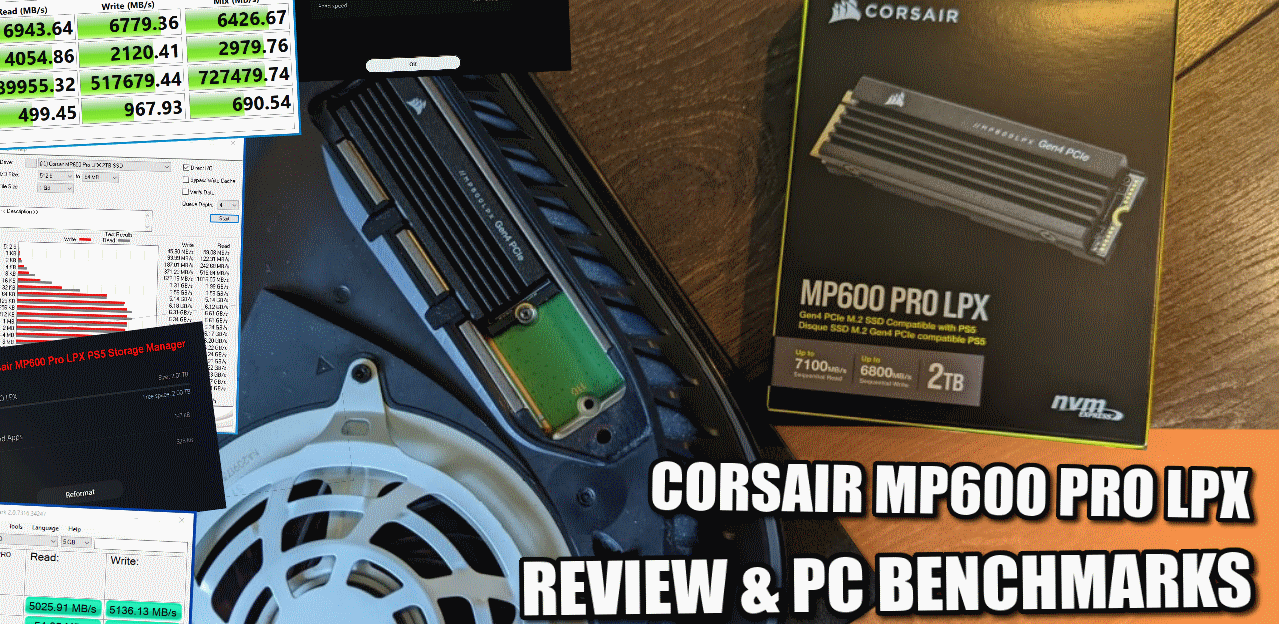
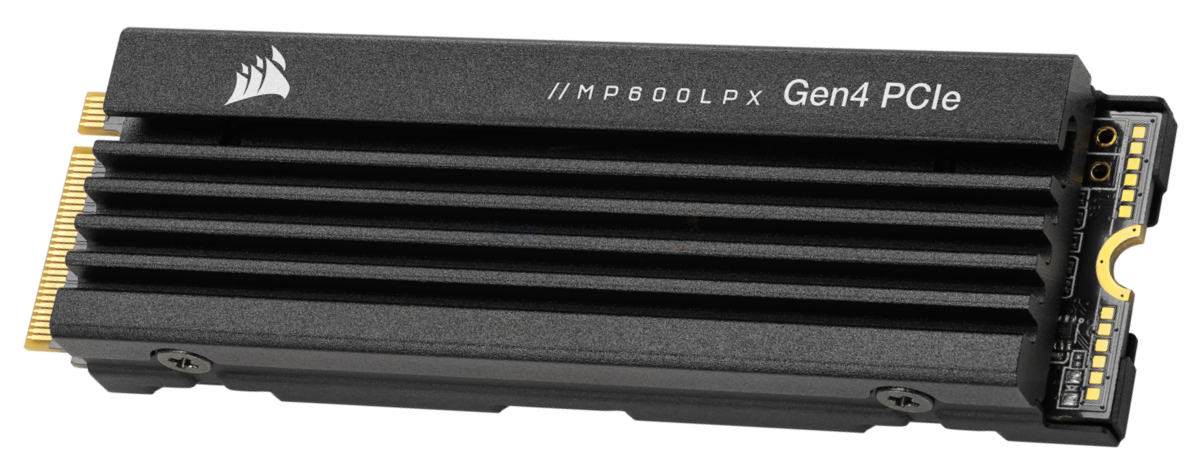






Removing the heatsink is impossible lol
REPLY ON YOUTUBE
3 of the screws came out perfectly, the 4th decided to round itself into oblivion. Bloody typical, guess it’s going back in the PS5 for now.
REPLY ON YOUTUBE
A really good & detailed video ????
REPLY ON YOUTUBE
Hi
i would like your help
which is better
Lexar NM790 1TB (with Heatsink) = 109 CAD
or
Corsair MP600 PRO LPX 1TB (with Heatsink) = 105 CAD
Thanks
REPLY ON YOUTUBE
what is the best nvme m.2 ssd for gaming with PC? I mostly find only 2 TB ssd but it is hard to find 4 tb ssd online…
REPLY ON YOUTUBE
2TB popped up on the Amazon Prime deals for £99. For that it seemed like a steal.
REPLY ON YOUTUBE
no difference lol
REPLY ON YOUTUBE
It sounds like a glowing review but you didn’t even have this in your top 8 ssd’s for the PS5 video?
REPLY ON YOUTUBE
Just grabbed a 2tb from best buy. Thanks bro!
REPLY ON YOUTUBE
Just got the 2tb on amazon for 122 out the door after tax. Seemed like a killer deal to me.
REPLY ON YOUTUBE
Thanks so much for this video you have the exact same one u have. All the way down to the 2TB. Thanks so much love u for this.
REPLY ON YOUTUBE
2 TB Corsair MP600 Pro LPX or the 2TB WD_sn850X with Heatsink ??? I can get them for essentially the exact price right now with a discount code I have. Which one should I get and why ? I’m so stuck I need help ????
REPLY ON YOUTUBE
I order the 4tb one as well
REPLY ON YOUTUBE
just bought it off your review, thanks sir!
REPLY ON YOUTUBE
My speed shows as 1776mb/s
REPLY ON YOUTUBE
Check BIOS DMI Gen setting, should on set to Gen 3 or so.
Check BIO DMI Gen setting, be sure it set to Gen 3 or so.
Be sure DMI Gen is set to 3 or so in BIOS.
Bro can’t even say terabyte
REPLY ON YOUTUBE
No other SSD stays cooler than this one. I think it is the best one one the market and not made in China like Samsung or getting 70°C like WDs
REPLY ON YOUTUBE
Why does the Corsair have a noticeable green tint ?
REPLY ON YOUTUBE
Hello
Can u help me please?
I dont understand it fit to pc or not?
REPLY ON YOUTUBE
I got the 1Tb model for $92 USD during a sale. At that price, along with the Corsair 5 year warranty and a preinstalled heatsink, I couldn’t resist.
REPLY ON YOUTUBE
Does reformatting the SSD really lower the performance? I’m super confused. If you format the drive and it’s 6550 on one test then reformat it again and get 5800 does that mean that the drive lowered in speed permanently? Please explain.
REPLY ON YOUTUBE
Kind of junky that removing the heatsink voids the warranty what if the motherboard has a heatsink to use and they don’t offer no-heatsink version so guess can’t buy this thing
REPLY ON YOUTUBE
I thought every gen 4 drive performed practically the same on ps5
REPLY ON YOUTUBE
Mine is in ancorage alaska being held up by customs. ????????
REPLY ON YOUTUBE
Well i started off with the wd sn850 with heatsink 1tb and i just barely ordered the 4tb corsair hope everything goes well
REPLY ON YOUTUBE
Bro how do we get that matrix awakens game
REPLY ON YOUTUBE
I’ve been using a Corsair MP510 480GB with three years and with the past two months I’ve been having trouble with it. When I am transfering files to it after a minute or two I get a WHEA UNCORRECTABLE ERROR BSOD. It happens when I’m downloading anything too. After about 10 – 15 minutes of downloading it BSOD.
I’ve changed my GPU , tested my ram and done a clean install of Windows as well as reseating my ram , reseated the 24 pin and six pin power on my main board and installed a 240GB SSD.
It’s so bad now that I left the computer Idle earlier today and after a half hour it BSOD.
I didn’t install a heatsink because I was sure the gen 3 NVME drives were ok without one and there’s no SSD shield on my MSI X470 Gaming plus.
So earlier today I installed a 240 GB SSD and proceeded to download something that caused my computer to BSOD about 10 times yesterday. I changed the download listen cation to the SSD and it didn’t crash once for the duration of the download of over an hour. I also copied 7.6GB of files from the NVME to the SSD without a problem. It’s only when writing to the NVME I get a BSOD.
So the reason why I watched this video is I was looking to see how good this NVME is. After the review I bought the drive. I bought a 1YB version
I’m just hoping my problem isn’t my main board or CPU because I can’t afford to change those for a few months yet.
I know my x470 is gen 3 NVME but I’m planning on upgrading to X570 and an 5800X3D.
REPLY ON YOUTUBE
I just built my PC and purchased the MP600 LPX SSD. I just failed on me after 12 days of use. I was just at the point of backing up my files. Lost them all. I don’t know what happened. I will be contacting Corsair tomorrow morning.
REPLY ON YOUTUBE
What would be the best ssd for the ps5 in your opinion (or anyone’s opinion)? I’m looking to get one soon
REPLY ON YOUTUBE
Corsair sold me a dead drive and it seems I’m not alone. ????
REPLY ON YOUTUBE
Don’t buy this drive, I’m an IT consultant. Have built my own pc with multiple m.2s. PS5 won’t recognise the drive.
REPLY ON YOUTUBE
I am wondering between corsair mp600 pro lpx and wd sn850 black with heatsink and aorus 7000s which is better for ps5 and pc
REPLY ON YOUTUBE
That thermal interface material is lackluster in the area of contact.
I think if yo repaste it yourself it would perform better in temperature aspect
REPLY ON YOUTUBE
It might be easier to remove the heatsink after putting it into you PS5/computer and letting it run for a bit. The heat build up might soften the paste. Might have to run a write benchmark for enough heat, though. EDIT: Running your benchmarks before removing the factory-installed heatsink would reduce any temperature variance due to the difference in mounting.
REPLY ON YOUTUBE
I think the LPX stands for Low Profile Storage, at least in this case.
REPLY ON YOUTUBE
Sup dad
REPLY ON YOUTUBE
For now I would not recommend Amazon affiliate but go to Corsair website
REPLY ON YOUTUBE
Does the elecgear heatsink fit above a firecuda 530 (with the cover) ssd?
REPLY ON YOUTUBE
Quite a bit off topic, but since you test so many M.2 drives, how do you store the one’s you’re not using? I just replaced a perfectly good one in my computer (for a faster one) and am sitting here looking at this thing the size of a stick of gum and wondering how I’m going to store it.
REPLY ON YOUTUBE
Your ps5 is downloading a virus. ????
REPLY ON YOUTUBE
Just to let people know, the SSD’s I’ve seen with the best Benchmarks are Samsung 980 pro, PNY CS3140, Western Digital SN850. PNY CS3140 on the majority of ps5’s runs the max benchmark of 6,558. However, PNY CS3140 may vary in benchmarks. PNY CS3140 can vary between 6,000 to 6,558. Western Digital SN850 gets a benchmark between 6,200 to 6,500. Samsung 980 pro with a firmware update you download from your Samsung Magician through your PC gets a benchmark of 6,400 to 6,500 on your ps5. Samsung 980 pro is the only ssd that I know that has a firmware update that is optimized for your ps5, so your benchmark will be more consistent than other brands. Without the firmware update, Samsung 980 pro benchmark on your ps5 is 5,500 to 5,700.
REPLY ON YOUTUBE
How many times can you say “SSD” in one video?
REPLY ON YOUTUBE
Which is the best performance SSD for the PS5? I’ve tried hunting benchmarks and figuring this out, but there’s not much information and it’s complicated.
I don’t care for thermals or power consumption (so as long as it’s okay for the PS5). I want the fastest SSD that maintains its performance the longest.
REPLY ON YOUTUBE